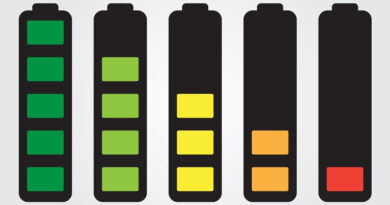Sustainable Orillia’s Tip Of The Week

Newest tips on top, check in every Saturday morning for new tips. If you have an idea to reduce waste, treat the environment better, or reduce carbon footprint that works, send it to Info@sustainableorillia.ca with the subject line: I've Got A Tip.
WINTER – YOU DON’T HAVE TO GET SALTY ABOUT IT
Without question, winter salt helps keep roads, parking lots, and pathways clear of snow and ice. However, as populations, traffic, and infrastructure grow, so does our reliance on salt, which isn’t necessarily a good thing.
It is possible to stay safe this winter and minimize the effect of salt on the environment.
While salt can make winter safer, it’s only part of the answer. Here are some other ways to protect yourself from slips and falls:
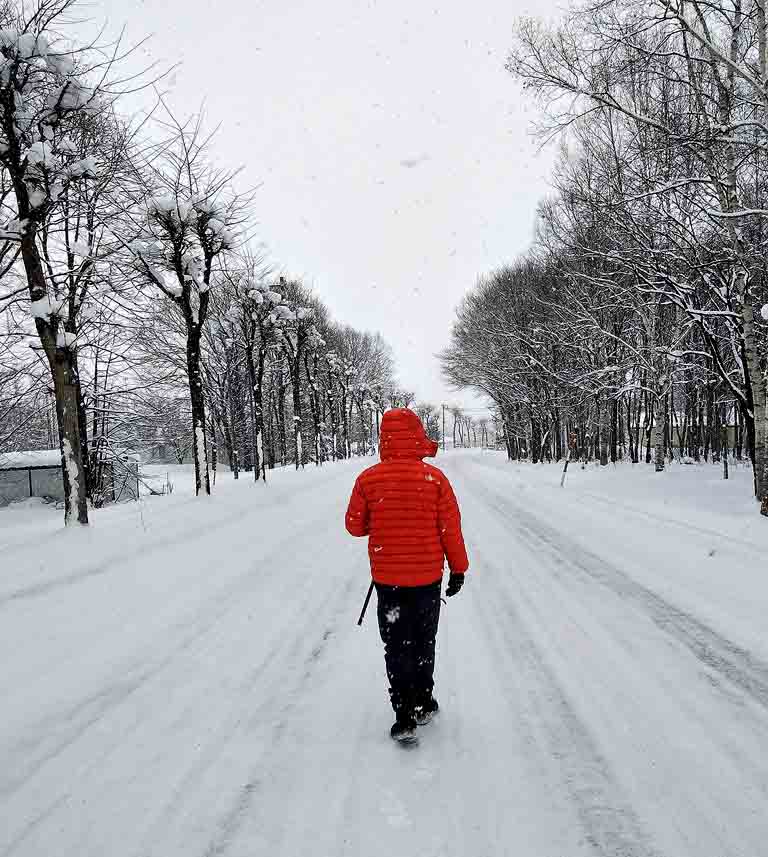
- Wear sturdy footwear designed for snow and ice. Boots should have a good tread for traction with low and wide heels. Check out this handy guide for buying proper winter footwear.
- Use snow tires. They do make a real and measurable difference.
- Slow down on the road. Give yourself extra time to arrive at your destination. Drive for the conditions and make sure you give plow drivers plenty of space to do their work.
- Use a traction aid like kitty litter or sand to reduce the potential to slip. Keep some in your car for emergencies if you get stuck.
To keep your driveway and sidewalk clear of snow and ice:
- Shovel first. When you remove snow and ice by shoveling, you’ll need less salt and it can be more effective. Get out there as early as you can and keep up with storms. You may even decide that salt isn’t needed.
- For icy patches use a traction aid like kitty litter or sand to reduce the potential to slip. Sprinkle de-icing material on icy areas only, and follow the manufacturer’s instructions for working temperatures and application rates. Give de-icing material time to do its work.
- Prevent icy buildups by redirecting downspouts away from walkways and driveways. Shovel unsalted snow to lower areas or onto lawns to direct melting snow away from paved areas.
- If hiring a snow removal contractor to clear driveways or lots, use certified contractors trained in reducing salt use while maximizing effectiveness and safety.
Sodium levels are already high in Lake Couchiching raw water. Winter road salt just adds to it. Let’s do our part.
A QUIZ: PERCEPTION VS. REALITY
The planet is barreling toward 1.5 degrees of global warming as soon as 2030 unless we enact “unprecedented changes in all aspects of society,” a United Nations report has warned.
To reduce our impact on the climate and avert disaster will take more than switching to high-efficiency light bulbs and the most effective ways individuals, policymakers and businesses can reduce our carbon footprint might surprise you.
Let’s see how much you know about what can be done to fight climate change. Which of the following actions with regard to our food do you think would have the biggest effect on curbing climate change?
- Compost waste
- Eat a plant-heavy diet
- Cook over clean stoves
- Throw away less food
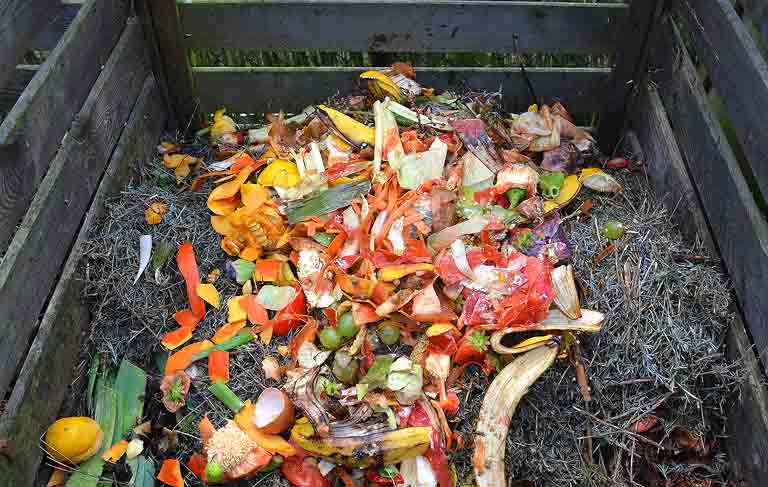
According to Project Drawdown which ranked solution effectiveness, reducing food waste would be most effective.
- Throwing away less food is similar to taking 511 cars off the road
- Eating a plant-heavy diet is similar to taking 479 cars off the road
- Cooking over clean stoves is similar to taking 115 cars off the road
- Composting waste is similar to taking 16.5 cars off the road
What else can we do within our own households to take more cars off the road? We’ll have more quizzes in other categories in future tips from Sustainable Orillia.
WORK SMARTER
In post-pandemic Orillia, some workers will be seeking opportunities in a different and likely more competitive job market. In addition, over time, advances in artificial intelligence are destined to replace many traditional jobs. Could this new transformed work environment present opportunities to test a four-day work week?
Over the centuries, work practices have changed dramatically from slavery and child labour to 12-hour days and seven-day workweeks to our current system, which itself is a relic of the 20th century. The standard five-day workweek was implemented after the Second World War. Now another shift is on the horizon.
Europe, Australia and New Zealand are ahead of North America in offering four-day workweeks. Where these have been implemented, employees report their lives have improved. They have time to rest, pursue other interests, explore nature, volunteer, enjoy the company of family and friends, and much more. “Life isn’t about making more money so we can keep buying more stuff; it’s about having time to do things that enrich our lives… rather than endlessly chasing a consumerist dream based on the illusory premise that a finite planet can support endless growth,” David Suzuki said.
There is evidence to suggest that four-day workweeks are good for both employers and employees, boosting employment levels and increasing performance and motivation. Reduced work hours, flexible schedules and telecommuting can also cut pollution and greenhouse gas emissions. The state of Utah gave government workers a four-day workweek from 2007 to 2011 (it was ended by a change in government) and concluded it saved $1.8 million in energy costs in the first 10 months and reduced greenhouse gas emissions by about 10,900 tonnes a year.

During the pandemic, many people have worked from home, often with flexible schedules, and learned to use technology for meetings and communication. Many say that they want to continue the practice post-pandemic.
Liz Supinski of the Society for Human Resource Management said, “we do anecdotally see more organizations interested in having the conversation to understand how it works,” although she concedes it doesn’t suit every work situation. Employers must have serious logistics in place, be able to respond to customers and still compete.
For example, customer-facing retail and hospitality job fields aren’t well suited to four-day workweeks and other flexible work-hour arrangements. “People expect the doors to be open all the time and to be able to go to the restaurant whenever they want,” Supinski said. “It’s not that flexible initiatives can’t be done; it gets more complex.”
However, she also said, “retention is the number one priority for employers,” and “generally speaking, work-flex variations are one of the least expensive ways to make employees happier.”
Employees should not be afraid to raise the issue of a four-day workweek with their boss. Research indicates that companies get productivity improvements and see fewer sick days. Employees should approach their boss with the economic argument, not just with the work-life balance argument.
Will private businesses in Orillia consider this shift? Will the City of Orillia? With many searching for a new and better normal once the pandemic is under control, the four-day workweek could be part of the life to follow.
IS SINGLE USE PLASTIC BAN ENOUGH?
The Canadian government recently announced it intends to ban plastic bags and other single-use plastics across Canada by the end of 2021. The ban includes straws, drink stirrers, six-pack soda can rings, utensils, and food containers. This ban is part of Canada’s commitment to achieving zero plastic waste by 2030.
“Plastic pollution threatens our natural environment. It fills our rivers or lakes, and most particularly our oceans, choking the wildlife that lives there. Canadians see the impact that pollution has from coast to coast,” said Jonathan Wilkinson, Canada’s Minister of Environment and Climate Change. The Canadian government has estimated that three million tons of plastic are wasted each year, and of this only nine percent is recycled. This is “the equivalent of 570 garbage bags full of plastic every minute, every day.”
There is plenty of evidence to suggest that this ban is totally inadequate if we are concerned about the health of the planet, of its oceans, and of the human population.
While it is understandable the government would give businesses and industry the opportunity to adjust to the banning of these materials, one has to wonder at the timidity of this first move.
Where, for example, is the ban on single-use water bottles? In Canada, estimates show, we consume two billion water bottles per year—about 5.3 million per day—and about 22 million pounds of plastic makes its way into the Great Lakes every year.
Does the ban include Keurig single-use coffee pods? Tim Horton takeout coffee cups? The plastic wrap around two peppers at the grocery store? The plastic wrap around single cookies or a piece of brownie for sale at your neighbourhood convenience store? The plastic containers around olives, blueberries, strawberries and many other fresh fruits and vegetables?
Take a look around you right now at your place of business or in your kitchen.
Notice how dependent we have become on plastic of all kinds. Records show in 2016 plastic companies produced 335 million metric tonnes of plastic, 50% of which went to single uses. It is likely the number has increased each year since.
We also now know that one of the ingredients of plastic, bisphenol A (or BPA), is harmful to humans in a variety of ways. We know that plastic can be found in each and every one of us, and many of us are adding more to our bodies every time we drink from a plastic bottle or eat from a plastic takeout tray.
By 2030, says the Canadian government? Should we wait that long? What can each of us do? First of all, take action for yourself. We tend to use plastic daily without really thinking about it. Think about it today – and every day. Find ways to live without single use plastics.
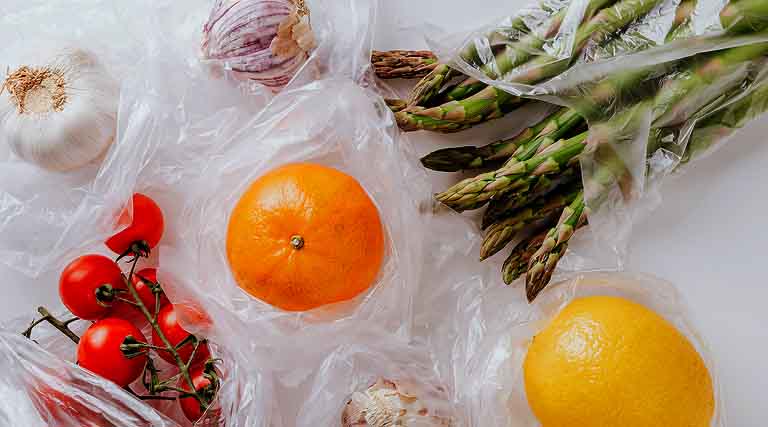
And speak up. Is your grocery store wrapping ever more veggies in plastic? Using more and more bags and plastic containers for the fruits on the shelves? Let the management know that you’re not impressed with their disdain for the planet – not to mention the health of their customers (that BPA, you know).
There is good reason to believe our planet and the living things on it, our lakes, oceans and us will eventually drown in plastic if we don’t start taking steps to end its use.
CREATE GREEN KIDS
Recently we relayed some tips we found in Kiwanis International’s magazine. We are seeing more and more publications reminding readers we should be doing our best to live more sustainable lives – lives that consider our personal and family effects on our environment.
Another publication, alive, in its August 2020 issue also provides a number of suggestions for individuals and families to become more eco-friendly. Writer Leah Payne, in Growing up Green (a great title), provided a list of tips to help parents ensure eco-friendly kids.
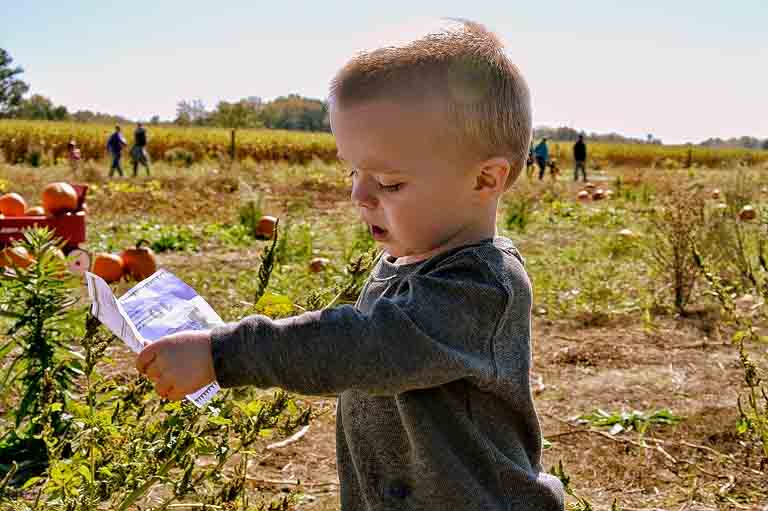
- Use cloth diapers
- Pack litterless lunches
- Visit farms and farmers’s markets to shop for local, seasonal foods
- Walk, bike, or take public transit when possible
- Take children with you to bulk or refill stores
- Cook and bake from scratch with your kids
- Get the kids involved in recycling and composting
- Bring on-the-go reusables: cutlery, napkins, travel mugs, water bottles, sippy cups and a soapy cloth in a wet-dry bag
- Repair clothing, and teach children how to mend
- Use your local library
- Organize a neighbourhood clothing, book, or toy swap
- Shop second-hand
- Get outside into nature as often as you can
- Donate to environment organizations and discuss this with your children
- Make DIY products with your kids (lip balm, bath bombs, or playdough)
- Forgo party balloons and use low-waste goodie bags for birthdays and celebrations
- Encourage non-material and experiential gifts
Payne quotes a parent who recommends, “Find parents and friends who have similar values as you. It makes it easier, and you can inspire each other to continue raising amazing children that love the environment and want to protect it.”
That’s a goal which will lead to a future world all children will enjoy living in.
MAKE HALLOWEEN GREENER
Halloween, like many holidays, can produce a lot of waste. It doesn’t have to. There are ways to reduce, reuse and recycle with every aspect of celebrating Halloween, says Caitlin Perry, program manager of the Recycling Council of Ontario (RCO). Here are some of her tips:
Costumes
The greenest costume option, and often the most interesting and fun, is make your own. “Just look in your closet and see what materials you might already have at home to create a new costume,” Perry says. It’s a rare closet that doesn’t hold the makings of a good, imaginative costume.
If that sounds too time consuming, how about trading costumes with a friend, or buying a used costume online or at Value Village?
If you need to buy a new costume this year, Perry recommends:
- getting one made of high quality materials you or others will be able to wear again and again
- avoiding cheap plastic fabrics, which often fray and shed microplastics and end up in our water
- staying away from glitter and sparkles – also sources of microplastics
- avoiding cheap plastic accessories like flimsy plastic masks. These are usually designed to be thrown away after use. The trouble is, there’s no away any more.
Decorations
Perry suggests make your own Halloween decorations from up-cycled or natural materials like pine cones, leaves or gourds. The RCO’s Plastic Action Centre recommends using cardboard boxes to make tombstones, or using up-cycling packaging materials into cats, bats, pumpkins and ghosts. If you really want to buy something, get durable decorations that can be re-used every year. Avoid decorations designed to be thrown away after one use (artificial spiderwebs, we’re looking at you.
Pumpkins

Please don’t get an artificial pumpkin “Go out and buy a real one,” Perry said. When carving it, she recommends using every part that you can, such as saving the seeds to roast and eat as snacks. Of course, if you didn’t carve your pumpkin, you can cook and eat the entire thing – after you cut or scrub off non-edible stuff. Make a pumpkin pie from scratch with your kids. After Halloween, compost it or put it in your green bin, or donate it to a local farm if they accept such donations for the animals to enjoy.
Treats
Public health officials recommend people take precautions when giving out candy. Many tiny treats given out at Halloween come in non-recyclable plastic packaging. Perry recommends the (few) options that come in cardboard boxes, like Smarties or Glosettes. Perry notes many of these tips can and should be extended beyond Halloween to make a greater difference: “Always think about the 3 Rs every holiday, and every day of your life.” Happy Halloween, everyone.
KIWANIS INTERNATIONAL BACKS TAKING ACTION
In its April/May 2020 issue of Kiwanis Magazine, Kiwanis International ran an article entitled 6 Things You Can Do Now, which addressed the urgent need for action on the climate crisis we are currently experiencing. While the article focused on things that individuals can do in their day-to-day lives, the introductory paragraph highlighted the need for action on all fronts:
“Our world needs transformational change. It’s time for the world to hold sectors accountable for their role in our environmental crisis while also calling for bold, creative and innovative solutions. This will require action at all levels, from business and investment to city and national governments.”
The article asks readers to consider six actions:

- Ditch plastic – Each year we use 4 trillion plastic bags worldwide and only 1% gets properly recycled. End plastic pollution.
- Eat a plant-based diet – Sustainable Orillia (SO) has urged this previously in the Tips. It’s a relatively easy change that has impact.
- Travel smarter – Drive less and fly less. “The transportation sector generates the largest share of greenhouse gas emissions.”
- Plant a tree – As SO Tips noted, trees are essential to fighting this climate crisis.
- Participate in a cleanup – Discover how much waste is right in front of us. Better yet, let’s end the practice of throwing things away.
- Register for an Earth Day event – April 22 declared Earth Day in 1970. The reality today in is every day needs to be Earth Day.
The article also urges readers, “Don’t underestimate your power” as individuals. “When your voice and your actions are united with thousands or millions of others around the world, we create a movement that is… impossible to ignore.”
We at Sustainable Orillia ask readers to do the same. There are people everywhere asking for real action to be taken to lessen the impacts of the climate crisis we’re experiencing – yes, experiencing.” The climate crisis is not something that is coming our way. It is here.
As a 15-year-old activist said elsewhere in the Kiwanis Magazine, “Keep fighting for a healthy and obtainable future… be an eco-friendly consumer.”
Please join us and the millions around the world who are changing the way they live and demanding action by business and governments.
A final note, the same 15-year-old makes the following statement in the magazine: “Disaster is inevitable if we do not change. Period.” As adults, do we really accept many of our children see their futures this way? We are experiencing an unprecedented global experiment at this moment in time, and our children and their children are the guinea pigs in the experiment.
Isn’t it time to demand, in the interests of our children and their children aggressive action must start now? Yes, now, today, this month, this year. Time is running out and our children know it.
GET OUTSIDE WHILE THE GETTING IS GOOD
To boost physical and mental health, doctors are increasingly prescribing spending time in nature.
One possible reason? Plants emit large amounts of phytoncides that protect them from molecular invaders, and perhaps, according to some research, humans, too. Dr. Suzanne Bartlett Hackenmiller, an OB-GYN and functional medicine practitioner in Iowa, says now is the time to “grab a tree and hold on.”
Studies show that spending just 15 or 20 minutes in nature improves our moods, calms our nerves, and lowers our blood pressure. A 2019 study from the University of Exeter Medical School suggested that people who spend two hours a week in green spaces are significantly mentally and physically healthier than people who spend less time outside, even adjusting for income and physical activity.
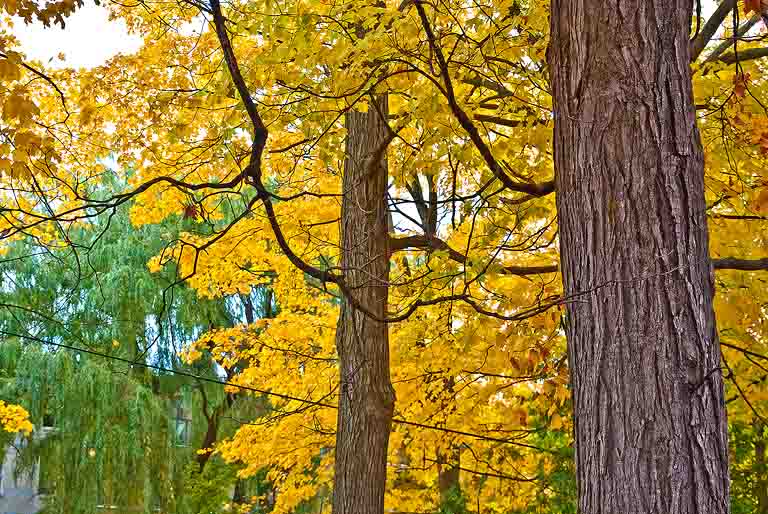
Perhaps even more important in these times, seeing beauty in nature appears to make us behave and feel more connected to one another. Public spaces are a reminder that we are still part of a civic collective at a time when we need this more than ever. Even a hundred and fifty years ago, in 1870, park designer Frederick Law Olmsted said that visiting these spaces is critical to democracy as well as to “our ability to maintain a temperate, good-natured, and healthy state of mind.”
If you’re working from home, locate your desk or chair near a window. Look outside at a tree, often, if you can. Listen to birdsongS, rain, or flowing streams as an antidote to the news. Consider making a regular habit of watching the sunset or the clouds as a reminder that we all live under the same sky.
In the Orillia area, we are so lucky to have these natural features in abundance all around us. As the fall colours begin to paint the landscape, there is no better time to get outside to enjoy the natural world around us.
Nature may be one of our best hopes for building and maintaining civilization.
TAKE A HIKE
Fall is here and after a summer like no other in recent memory, cooler nights remind us change is on its way. Here in the Orillia region, we are fortunate to have numerous hiking trails and woodland walks that will keep many of us outside enjoying nature – healthy and safer from the coronavirus’s tentacles well into November.
Have you been to Scout Valley lately? It’s Orillia’s answer to New York’s Central Park, a spectacular, walkable loop trail in the heart of our city. A little further from town, Copeland Forest offers unbounded natural beauty, and Grant’s Woods (Couchiching Conservancy) has several welcoming trails. For hikers, joggers and cyclists, the delightful Uhthoff Trail runs from Orillia through Coldwater to Waubaushene, but you can take it in bite-sized sections.
So dust off your hiking boots and head off for the woods. But as you do, please keep the following guidelines in mind:
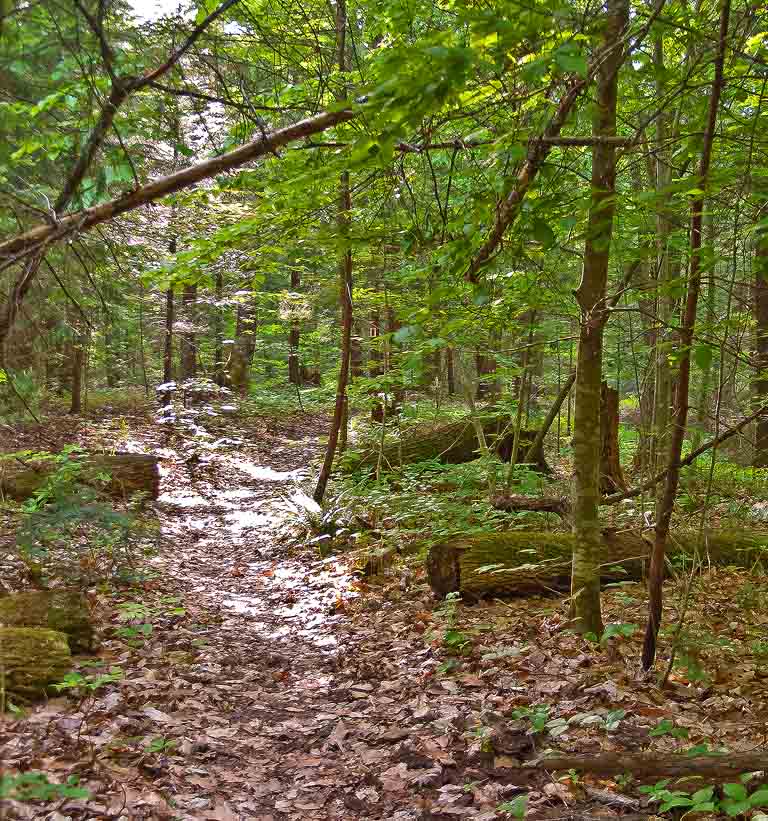
- Be sure to tell someone where and when you’ll be hiking
- Be very careful with anything that involves fire.
- Stay on trails and leave habitats undisturbed.
- Breathe deeply, hiking is an oxygen-rich experience.
- Leave no trace – pack out your wrappers and containers, cigarette butts.
- Listen to and count the many sounds of the forest.
- Take the time to notice the small miracles everywhere around you.
- Don’t feed wild animals, nature looks after that job best without human interference.
- Long pants, long sleeves and good footwear will help protect your body from uneven ground, scrapes and insects.
- Keep your dog leashed and under control. Some people have a legitimate fear of them, especially larger ones. “He’s really friendly” doesn’t always help.
- Say a simple “hello” when you pass other hikers.
It may also be wise these days, as our warming atmosphere allows for more ticks to move into our area, to take precautions when returning from your time in the woods. Check yourself and your pets over carefully and then enjoy the relaxed feeling you’ll have after your time with nature on an outdoor trail.
THINK ABOUT THIS, HOLIDAY TRAVELLERS
Coronavirus fears have made air travel unpopular these days. Many individuals and families are keeping their vacations close to home. Air travel is dramatically down while campgrounds in Ontario were full.
In addition to the threat COVID-19 and flights pose to our health and safety, airline flights are a threat to the global climate. The burned fuel produces greenhouse gases, mainly carbon dioxide, which contributes to global warming when they enter the atmosphere. A return London-New York flight produces an estimated 2/3 tonnes of CO2 per passenger, according to the UN’s International Civil Aviation Organization. That’s about the same as the emissions caused by someone living in Ghana over an entire year.
Aviation contributes about 2% of the world’s global carbon emissions, according to the International Air Transport Association (IATA) and the IATA predicts passenger numbers will double to 8.2 billion by 2037. As other sectors of the economy become greener – with more solar panels and wind turbines, for example – aviation’s proportion of total emissions is set to rise.
What is an environmentally conscious traveller to do?
Let’s compare various forms of transportation based on the amount of carbon dioxide released per kilometer travelled. Of course, the higher the number of people in any given vehicle, the lower the per-person emissions.
The chart that follows demonstrates the enormous GHG impact of vacation flights, one of the reasons that travelers, if they must take a plane, are urged these days to buy carbon offsets to compensate, at least somewhat, for the emissions caused by taking a plane to our destination.
It’s also worth noting how much impact is caused by jumping into a car to travel if it means traveling alone. Clearly
cars are also major problem when it comes to emissions.
The chart is based on United Kingdom standards of transportation. You’ll notice car refers to the average diesel car. Eurostar is the high-speed electric train that runs from London to Europe through the Chunnel. High-speed trains in Europe are clearly the greenest method for European travel, and also a good choice for Canadian travelers once they arrive in Europe.
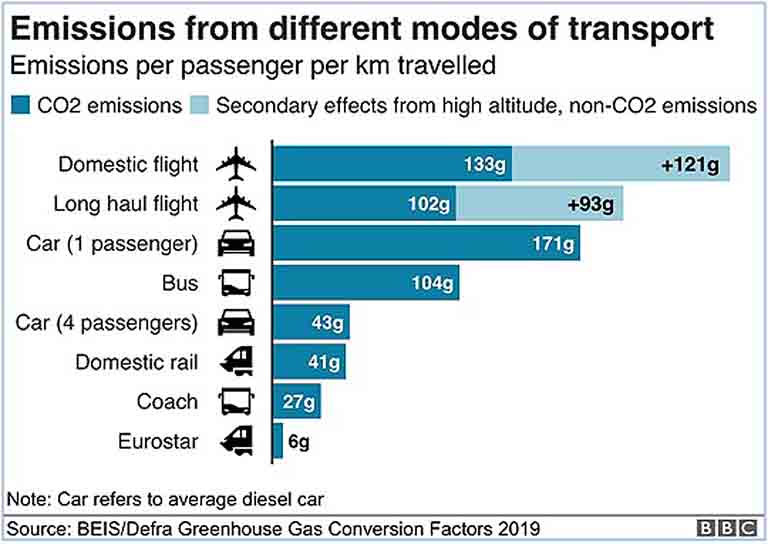
European countries, with their denser populations, have created a more convenient rail system for travelers than we have in North America. Despite this, governments here too, will be looking at changes in transportation to reduce our domestic emissions. It won’t be long before electric cars, buses and trains are the norm.
In the meantime, hiking or bicycle holidays, anyone?
TAKE TO THE STREETS
During the COVID-19 pandemic, cities worldwide have been repurposing streets to create more room for walking and cycling. In some, temporary measures to help people maintain physical distancing, like lower speed limits and limited car access, are providing impetus for permanent changes that prioritize healthy mobility choices over cars. Cities are being re-imagined as places not just to move cars with single occupants as quickly as possible, but as places where everyone has the right to get around safely.
Montreal is adding 200 kilometers of temporary active transportation routes and reconfigured streets for cyclists and pedestrians. Vancouver is repurposing 50 kilometers of road space for active transportation. Paris is remodelling its core for more mobility options, barring older polluting cars from entering, and adding 650 kilometers of pop-up cycle ways. Seventy-two per cent of its on-street car parking spaces are being removed to accommodate new bike lanes. Milan is transforming 35 kilometers of streets over the summer with low-cost temporary priority cycle lanes, widened pavements and reduced speed limits to expand cycling and walking spaces.
In the U.S., Portland and Oakland are creating slow/safe street programs, modifying and closing roads to vehicle traffic. Bogota, Colombia regularly closes 120 kilometers of arterial city streets to motorized traffic every Sunday between 7 a.m. and 2 p.m.

The safety and health benefits of repurposing streets away from car domination are clear. During the pandemic, more and better pedestrian and cycling space allows for safe exercise and easy access to necessities, relieving pressure on roads and transit. Many countries, including China, Germany, Ireland, the U.K., the U.S. and Canada, have seen a surge in urban cycling during the pandemic shutdown.
Cities are reimagining public spaces with wider, more interesting sidewalks, extended patio areas, and creative laneway redesigns. Street parking spaces can be converted to outdoor dining areas, docks for bike shares or pollinator-friendly gardens. Economic recovery efforts could focus on ways for unemployed culture-sector workers and artists to animate public spaces to welcome people back.
Building active transportation infrastructure is a good bet for economic recovery. A University of Massachusetts study found for every dollar invested bicycle infrastructure projects create more employment and use more locally produced materials than car only road projects. They can create up to 11.4 jobs for every $1 million invested – 46 per cent more than car only road projects.
As municipal governments improve active transportation options, senior governments can’t ignore the need for public transit emergency operating funding. As well as being an important climate solution, well-functioning transit will be key to preventing a rush back to cars.
The shortcomings of car-oriented streetscapes are being highlighted like never before during the pandemic. The health crisis is forcing cities to rethink how people get around and to consider possibilities for connected, car-free corridors. Today’s temporary solutions are pointing the way to tomorrow’s healthier, safer, more resilient cities which welcome everyone.
From: Reimagining streets… David Suzuki/Theresa Beer
WHAT DOES NORMAL LOOK LIKE?
Hands up – how many of us are longing to return to normal as soon as we have a vaccine?
While our COVID-19 trials will one day be history, returning to normal means continued climate disruption, species extinction, growing inequalities, high levels of pollution, health risks and the possibility of new disease outbreaks. That’s not a very attractive normal to return to.
Turns out that not everyone is a loser in these tough times. The world’s millionaires (36 million of them) are expected to do the best in the coming years, and their numbers are expected to grow to 44 million by 2022. The wealthiest 1% of the world’s population now owns more than half of the world’s wealth, according to a 2017 report from Credit Suisse. When that one per cent is largely behind the push to get the economy rolling, no matter the human cost, then we know change is necessary.
Governments at all levels are working on how best to tackle the problems exacerbated by the pandemic. Since more than 80% of Canadians live in urban areas, we know that the way towards a fairer, cleaner, greener, de-carbonized economy will begin with our cities by undoing decades of bad habits that have compromised our health, access to housing, and the quality of our air and water.
A month ago, more than 50 prominent Orillians committed to creating a city that:

- travels far fewer kilometers in gas- and diesel-fueled vehicles, and many more by foot, bicycle and public transit,
- boasts many more electric vehicles and charging stations,
- substantially expands renewable energy sources,
- builds and retrofits energy-efficient, low-carbon houses and other buildings that are much, much better at separating heat from cold,
- ensures everyone is permanently housed, local food production is increased, and jobs are created,
- ensures access to clean water and clean air for all,
- plants more trees and pollinator gardens, and grows food in our own or community gardens,
- protects our lakes from damaging storm-water run-off,
- phases out single-use plastic and reduces food waste,
The pandemic has thrown municipal governments into a period of unprecedented financial uncertainty and huge budget shortfalls. New sources of revenue will be necessary. Municipalities like Orillia have it within their power to reassess priorities and reallocate resources away from approaches that are not viable over the long term toward sustainable, equitable, cost-efficient ones.
As miserable as the pandemic has been, especially for the most vulnerable among us, it has also shown us what is possible. We know now we can reduce greenhouse gas emissions and pollution. We have seen that caring for and about each other will get us through tough times. We know that every Orillia citizen can make a positive contribution to our city’s long-term health and well-being.
In truth, our responses to the pandemic have shown us the way forward in the new normal to come.
THE IMPORTANCE OF TREES
Diana Beresford-Kroeger’s To Speak for the Trees is a fascinating book about the author’s lifelong relationship with the natural world. She is recognized around the world as botanist, medical biochemist and author whose work uniquely combines western scientific knowledge and the traditional concepts of the ancient world.
Beresford-Kroeger is well aware of the threat that climate change poses for humans on this planet. But she also has faith in two things: first, what human beings individually and collectively can accomplish if we put our minds to it; and second, the natural world’s powers of regeneration and restoration.
Many people, given the threat of the climate crisis, feel quite powerless as individuals. Yet it is essential that all humans, including those of us living here in Orillia, realize that there are things each of us can do to prevent the worst of the crisis. Listen to the words of this author, then consider the actions you’ll take.
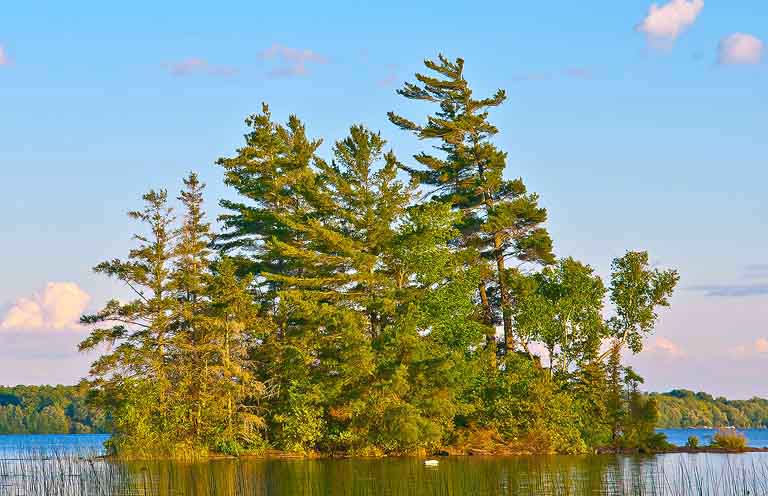
“Climate change is the biggest challenge humanity has ever faced. It touches every living thing. It is a daunting task to even see the entirety of it. To try to think of solutions can, for any individual, quickly begin to feel like an impossibility. Because the problem is so big, many people simply turn away; they deny it exists at all. Others acknowledge the truth being shouted out by every climate scientist on Earth only to embrace the cynical belief that people will never change and there’s little point in trying to save the planet – we’re all doomed. I’ll put it plainly: I have no time for anyone prepared to turn away or throw in the towel.
“Positive action, no matter how small, builds toward your bigger goals… every effort to aid and encourage the natural world is as valuable as every other. Whether we are the mighty or the meek, we must all act to stop climate change. We are all siblings in the communal family and the natural world is our commonage.”
“You’ve got to stay on your hind legs and take a swing – all of us do. You’ve got to take a first step towards a goal that seems unachievable, and have the integrity and courage to believe that you will reach it one day. We all have immense courage. Every one of us is capable of extraordinary things… when we believe in ourselves and keep moving towards the impossible.”
“Stopping climate change in its tracks can feel like the impossible. The latest science tells us that as of 2019 we have just ten years to halt global temperature rise… but my life and work have taught me that nothing is ever as dire or insurmountable as it seems, and that the natural world’s powers of regeneration and restoration stretch far beyond our understanding.”
Beresford-Kroeger asks each of us, at the very least, to do the following:
- Plant one tree per year for the next six years. (“if every person on Earth planted one tree per year for the next six years, we would stop climate change in its tracks.”)
- Make a personal bioplan. (“You take the first step that you’re able to take. The true goal… is for every person to create and protect the healthiest environment they can for themselves, their families, the birds, insects and wildlife.”)
- Protect all the forest we already have. (“When we cut down a forest, we only understand a small portion of what we’re choosing to destroy.”)
- Band together to take on government and industry (“[We] can keep informed of plans to destroy forests and fight them at every turn.”)
- Become a guardian and steward in our own neighbourhoods and towns. (“If you have a large tree on your street, make sure your local council knows that you value it.”)
- Vote for people who will protect our forests and waterways. (“Every opportunity to vote is an opportunity to put someone who cares about forests in a position of greater power and authority.”)
The author notes that the task we humans face may seem impossible. But, “there’s a simple way to get there; just take the first step and keep on going,” she said.
You may have taken that first step already. If not, today’s the day to take it. If you’ve already taken that first step and others keep on going.
LABOUR DAY AND GREENER WORK
As many of us find ourselves in enforced idleness during the pandemic we might consider the words of philosopher Bertrand Russell in his In Praise of Idleness : “I think that there is far too much work done in the world, that immense harm is caused by the belief that work is virtuous.”
Russell advocated for a gradual reduction in paid labour to four hours a day. This, he argued, would facilitate full employment, provide more time for creative pursuits and contribute to the public good. “In a world where no one is compelled to work more than four hours a day, every person possessed of scientific curiosity will be able to indulge it, and every painter will be able to paint without starving,” he wrote.
He was writing about paid work, but his point could be understood as a call for less activity in general, a request to sit still. Everything we do uses energy. Doing is polluting. Doing is warming. Almost by its very nature, doing contributes to the climate emergency. Inactive, we’re less harmful to the planet we live on.
Where could idleness be introduced?
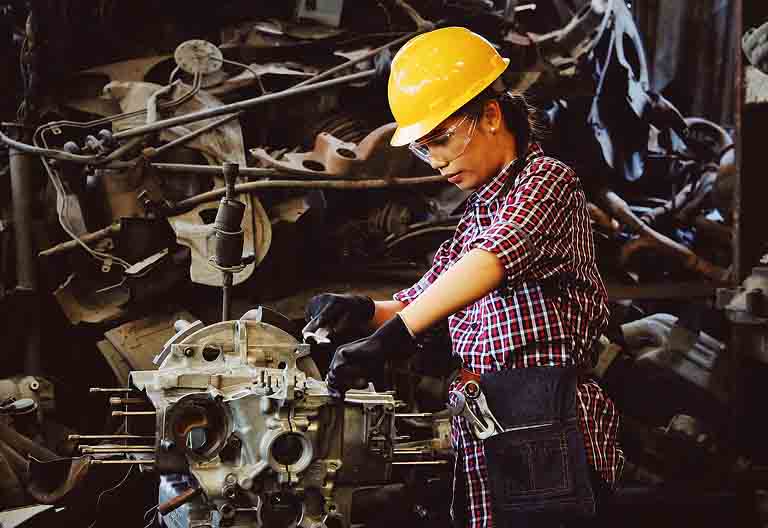
What about transportation? Environmentalists urge us to abandon gas-powered vehicles and embrace electric ones. Perhaps we need to go even further. Maybe the problem isn’t just fossil-fueled movement but movement overall – not only how we move, but that we move so much. Perhaps the deeper solution isn’t travelling by fuel-efficient or electric vehicles but calling travel itself into question. Maybe the best thing we can do is the least.
We might consider sleeping more. Asleep, we generally use fewer appliances and lights and require less hot water, heating and air conditioning. Time spent in bed is Time not spent driving. Throughout Canada an additional hour, or even half-hour, of sleep per night could represent a significant reduction in fuel – to say nothing of health benefits for sleep-deprived people.
That doesn’t mean we should adopt ubiquitous idleness. Rather, we should consider selective idleness. When it comes to climate activism, for example, we require more action, not less.
Illnesses force idleness on people. We require time in bed to recuperate; rest is non-negotiable. So, too, the climate situation demands idleness from society. As we must listen to the body in sickness, we must listen to the planet in crisis. At the very least, we need to slow down.
The pandemic is forcing many to think about how we work. Russell’s suggestion may seem extreme in 2020, but in his article he questions the wisdom of asking workers to work long hours each day while other workers remain unemployed and poor.
Perhaps we might also consider Russell’s advice: “When I suggest that working hours should be reduced to four, I am not meaning to imply that all the remaining time should necessarily be spent in pure frivolity. I mean that four hours’ work a day should entitle a man to the necessities and elementary comforts of life, and that the rest of his time should be his to use as he might see fit.”
SIMPLE STEPS TO A GREENER HOME
Let’s take a walk around our homes, room by room, with an eye to making some small changes that will make our homes more eco-friendly. It doesn’t matter if we live in a big or small house, an apartment or a condo, because most of these tips will be relevant regardless of your living circumstances. The goal is to save energy and reduce waste and greenhouse gas emissions while improving the overall quality of our interior worlds.
There is lots of information available on how to make your home more carbon neutral, but many of those projects entail larger investments of time and money. So we’re starting small today with some practical, DIY types of actions. The good news is just a few small tweaks can make a difference – a positive difference.

In the Entranceway – The number one tip here is to ensure the weather stripping around any outside door is sealed and doesn’t permit drafts between the outside air and inside when closed.
In the Living Room – Green plants help remove carbon from the air. Whenever possible use outside air to cool your home in summer, close drapes in the heat of the day to keep sunlight and heat out; open them in the evening to let cooler air in. During colder months just keeping the thermostat a degree or so lower while wearing a sweater will save energy. A rug on the floor has the potential to save between 4% and 6% of the energy required to heat the room. And if you’re not watching your television, how about unplugging it to save more electricity?
In the Dining Room – if natural lighting isn’t practical, we advocate LED lighting in every room; softer LED lighting is ideal for the dining room. Re-usable serviettes and cutlery go a long way to reducing waste headed straight to the land fill.
In the Bedrooms – lower temperatures not only save energy, they usually
encourage a better sleep. This is especially so if you are tucked in between natural fiber sheets such as organic cotton, or sustainable bamboo, or sleeping under a pure wool blanket – these are among the most eco-friendly fibers available.
In the Bathroom – A low flush toilet will save water, as will turning off the tap while shaving and brushing your teeth. Showers are more eco-friendly than baths, and a spider plant in the bathroom will go far in helping to purify the air. 2-ply toilet tissue versus 3-ply is the greener option.
In the Kitchen – one of the most obvious green options is to compost. Ensure that you have a receptacle handy for all of your kitchen waste to go out in the green bin every week, better yet, into your own compost pile in the backyard. Minimize how often you open an active oven or fridge door to avoid significant energy loss. Speaking of ovens, a microwave uses about 50% less energy than a conventional oven and is a great alternative whenever practical. Vinegar is a natural way to clean and kill bacteria and germs around the kitchen.
These are just a sampling of some small steps any of us can take, so whether you have more rooms or fewer than mentioned here, we hope you have found some of these thoughts helpful in making your home, room by room, a greener environment.
BE A GREEN BOATER
Boating season is well underway and there is nothing more pleasant than a gentle breeze and a gentle cruise, or perhaps a peaceful day fishing or simply enjoying and exploring nature on one of Orillia’s lovely lakes or nearby waterways.
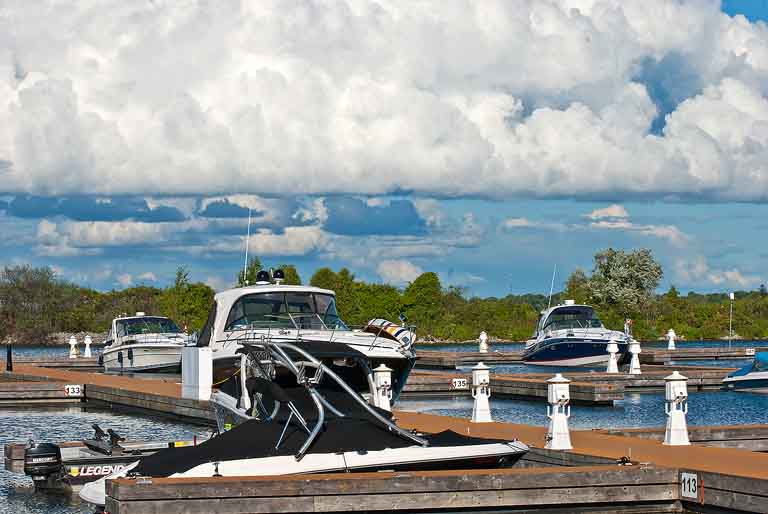
Although Sustainable Orillia’s preference is for non-motorized watercraft such as canoes, kayaks, sail boats and paddle boards, motor boats are a very popular fixture on all our waters. As such, they deserve attention and a little care to make them as green as possible.
Most boaters have a deep appreciation for the environment and, in particular, for the overall and lasting health of our lakes and rivers. Sadly, there are still some who need a nudge as poor boating practices have led to lasting damage such as noise pollution, oil and fluid spills, sediment disruption, erosion and the disturbance of fish habitats. So here are some environmentally friendly boating tips to keep you green out on the blue.
- Regular boat maintenance ensures your vessel is safe for the water and generating as little pollution (leakage, fumes, etc.) as possible. How you maintain and operate your boat has a great effect on how much fuel you use.
- Did you know that to get improved fuel efficiency once your boat is up on plane, gently pull back on the throttle just a little?
- Ensure you boat is free of zebra mussels and/or other invasive species before putting it in the water.
- Be careful to avoid spillage when filling up at a marina or dock, or when filling a portable fuel container. Ideally, fill up on shore and keep your gas line and fuel tanks tightly sealed.
- Keep a supply of rags on board to mop up any oil or fuel spills as they happen and dispose of these following the hazardous waste protocols in your region.
- If you do have an oil spill DO NOT use soap to disperse the spill. It can cause lasting harm to the environment and is illegal in most jurisdictions. Use absorbent socks, pads and pillows in open-water spills to minimize damage
- Use natural and non-toxic cleaning solutions for the exterior of your boat.
- Avoid creating wakes near shore to prevent sediment disturbance and shoreline erosion. The maximum speed recommended within 100 feet of any shore is 9 km an hour.
- Be cautious and slow down near natural habitat sites, particularly wetlands and known spawning grounds.
- Keep all your trash on board, including seemingly harmless items like food scraps or cigarette butts, and dispose of them properly once back on land.
These are just a few environmentally conscious tips that will allow you to be safer and enjoy your time out on the water. Thank you for helping to protect the health of Orillia and Canada’s greatest asset – our freshwater lakes, rivers and waterways.
Thanks to the The Land Between, Discover Boating and Sailors on the Sea as sources for these important tips.
TRUTH IS, WE ALL LIVE IN FIXER UPERS
COVID-19 has curtailed many of the activities we took for granted up until earlier March: going out for dinner, seeing a movie, having friends over, going to a concert, or planning a vacation. While some of the prohibited activities are starting again as we seek ways to return to some semblance of normal, other activities may remain out of reach for some time.
Given this reality, many of us may be looking at what we can do with the money we might otherwise have spent on concerts, restaurant meals, and travel. Pool companies, apparently, have more work than they can handle this summer. This week’s tip from Sustainable Orillia is to consider a home renovation (or a retrofit) which will save you money in reduced energy costs.
BF Nagy, author of The Clean Energy Age: A Guide to Beating Climate Change, provides a top 10 for home-owners to make their homes more energy-efficient. He lists them in order of their impact on saving energy. Here they are:

1. Focus first on optimizing the building envelope – insulation and double- or triple-pane windows
2. Switch to clean, efficient heating and cooling
3. Save by recovering wasted building energy
4. Install geothermal or solar thermal and solar photovoltaic (PV) panels
5. Invest in smart home technology, including a user-friendly thermostat
6. Replace old lighting with LED lighting
7. Replace old, inefficient appliances with Energy Star models
8. Use power strips to cut power to appliances when not using them
9. Add drain water heat recovery to your shower pipe
10. Choose modern low-flow plumbing -toilets, faucets and showerheads
Nagy’s book is persuasive. While acknowledging some steps (e.g. triple-pane argon windows) are expensive, he also shows how the savings which can result from taking the steps above will pay in energy cost savings for the work you have had done – and often much more quickly than one might expect.
It may be some time before we can resume some of the activities we enjoy, whether attending a concert, a Raptors game, or traveling. Why not turn this into a positive by both reducing your carbon footprint by reducing your energy use and then saving yourself some money. It’s a win-win for you andthe planet.
Nagy’s book can be ordered from Manticore Books in Orillia. You’ll find details about the home owners top 10 there, along with a terrific amount of information about the technology and products available to those who want to cut energy costs.
HOW TO RECYCLE BETTER
Ever wonder what happens to your paper and plastic after curbside pick-up? While each item has its own journey, most still ends up in landfills because of inconsistent recycling practices. Canadians produce approximately 3.3 million tons of recycling per year, but only 9% is recycled, meaning over 2.8 million tons either burned for energy or dumped in landfills.
If recycled properly, items such as aluminum cans, plastic containers, glass, and cardboard can be melted or broken down into new products including cookware, fleece, fiberglass, garden supplies, or even parts for bicycles, cars, and airplanes. On the other hand, if these items are placed into the wrong bins or sorted incorrectly, they can take hundreds of years to decompose.
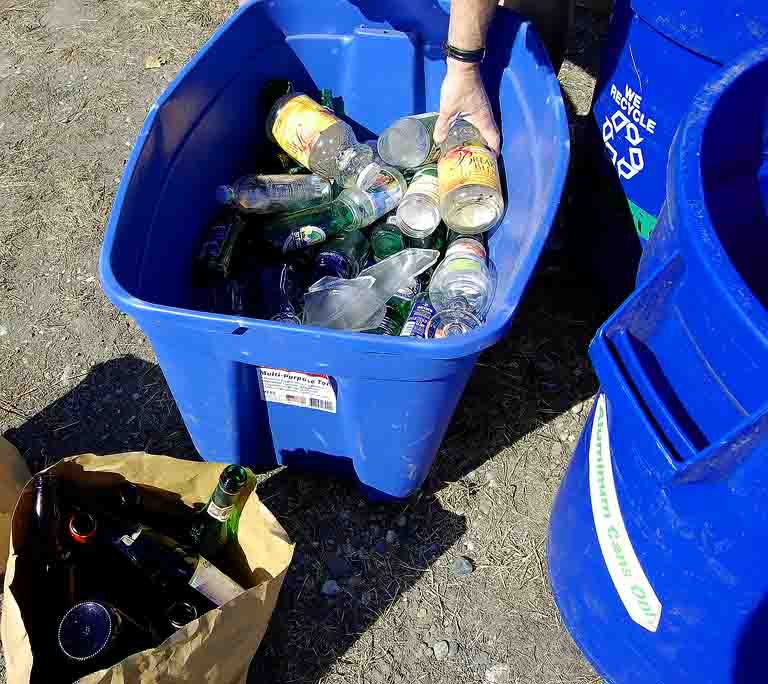
In Orillia, waste should be properly sorted before pick-up. To ensure items are sorted correctly follow the waste collection guide, which explains what is and is not accepted by the city’s disposal program. Unlike many other municipalities, Orillia will accept styrofoam packaging and plastic grocery bags, but it is important those items are placed in a bag and tied at the top to avoid being mixed among the other recyclable content. The City of Orillia wants people to “place the tied bag of bags (or bag of clean Styrofoam packaging and trays) in or beside your recycling box for paper” to ensure proper disposal.
Orillia does not accept:
1. Coffee cup lids (hard to sort due to small size)
2. Single serve coffee pods
3. Bubble/stretch wrap
4. Chip/snack bags
5. Meat/cheese wrapping
6. Cereal box liners
7. Light bulbs
8. Ceramics
9. Window glass
10. Mirrors
11. Drinking glasses
12. Foam packaging peanuts
13. Diapers
14. Toys & electronics
When recycling, it is important to look for the numbers labeled on each item. For example, plastic bottles are often labeled with a 1 and are easiest to recycle into more bottles or polyester fibers. Other plastics such as laundry detergent or milk containers are often labeled with a 2 and are also fairly easy to break down. Numbers 3 to 7 are more difficult to recycle, so it is important they are sorted and disposed of properly. Usually, any item that has a number can be placed in the blue bin for curbside pick-up. If an item does not have a number (such as a plastic hanger, children’s toy, or toothbrush), it cannot be recycled.
The colour of your recyclable items is also important to take note of. Brown and black plastic are very difficult to recycle. Since Orillia uses machine-sorting, dark colours often blend in with the conveyor belt and are therefore misplaced into the garbage pile and sent to landfill. While the City asks for black plastics to be placed in the blue bin, Simcoe County’s Waste Wizard, an online tool with recycling recommendations, suggests placing black plastics into the garbage rather than attempting to recycle them. Either way, try to avoid purchasing items that use dark plastics such as Tim Hortons cup lids and take-out containers.
No matter the item that is being placed in a bin, it should always be separated (i.e. lids and cups, caps and bottles) and cleaned out before disposal. If you are unsure where an item belongs, research your local municipality or call your local waste-management team.
Recycling tips sent by Izzy Nolan
CHEAPER, AS EFFECTIVE, ECO-FRIENDLY LAUNDRY
With the Earth’s temperature continuing to rise, local and global communities are becoming more aware of climate change impacts. As a result, Ontario is seeing a rise in environmental initiatives such as carpooling, reducing single-use plastics, and supporting local businesses. What is often overlooked is the province’s laundry habits, which can result in significant energy and water consumption, as well as high carbon emissions.
Using a front-loading washer, switching detergents, and air-drying wet clothes are a few of the many ways households can practice eco-laundry habits and reduce their personal carbon footprint. By following 6 simple and effective strategies, families can consume less energy, waste less water, and save more money on laundry day.
Switch to a front-loading washing machine
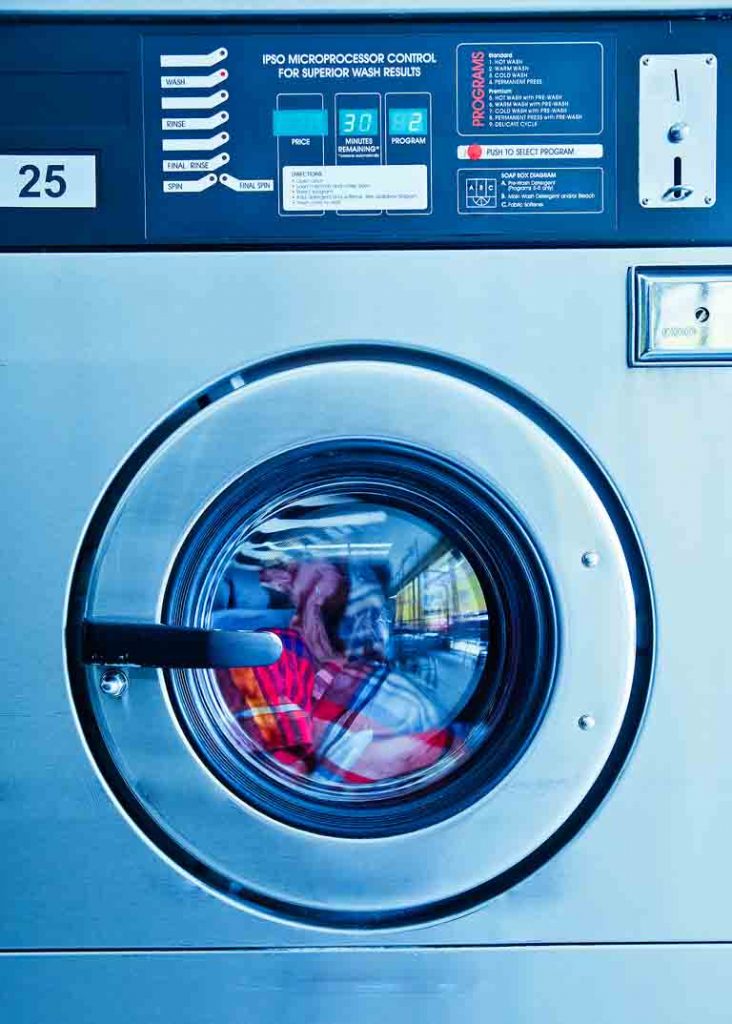
By switching to a front-loading washing machine or purchasing an Energy Star product, households can save hundreds of gallons of water per year, saving on energy and water bills. While a top-loading washing machine uses approximately 28 gallons per load, front-loaders tend to wash clothes with less water, using around 13 gallons per load. Energy Star products are also known to use 25% less energy and 33% less water, resulting in hundreds of gallons (and dollars) saved. According to Treehugger, switching to a front-loading washing machine can save at least three swimming pools of water over the span of 11 years, providing a lifetime of water for six people.
Wash clothes in cold water
By washing clothes in cold water, much less energy is being consumed and wasted. Because 90% of the energy consumed is used to heat water (and only 10% to run the motor), it is much more sustainable to eliminate the heat and wash using cold water. Cold water also reduces the possibility of shrunken, faded, or damaged clothes, making their lifespan in the closet much longer and time in the landfill much shorter. If every household were to wash their clothes in cold water, 34 million tons of carbon dioxide emissions could be saved annually.
Only wash full loads every two weeks
Rather than weekly laundry schedules, consider washing clothes biweekly. By washing clothes twice a month (or only when necessary), at least 5 times less energy is consumed. Eliminating unnecessary loads can save 99 pounds of carbon per household. Micro-plastics and fibers have also become an environmental concern. Approximately 14,000 tons (2 full garbage trucks per day) of micro-plastic are shed into water systems per year. Avoid mindlessly washing clothes, such as those that are wrinkly or only worn once. Products such as the Cora Ball are also making a splash in environmental news because they capture tiny microfibers during laundry and stop them from travelling into our water ecosystems.
Use laundry strips rather than detergents
Products such as Tru Earth Eco-Strips can reduce your carbon footprint in many ways. Since the product is paraben, phosphate and bleach-free, biodegradable, and plant-based, it promotes healthier drains and healthier local bodies of water. Cleaner water means cleaner eco-systems, as regular detergents often result in algal blooms and pollution. Tru Earth, and other sustainable companies, also claim lower carbon production using compostable, light-weight packaging rather than a single-use plastic bottle. This results in less landfill waste and less fuel consumption, which can reduce carbon emissions by 94% because switching to strips means 1 billion plastic laundry jugs can be saved from landfills, and enough truck fuel will be saved equivalent to 27 million cars taken off the road or planting 9 million trees.
Hang dry clothes on a rack or clotheslines
Using indoor drying racks or outdoor clotheslines, rather than a drying machine, has significant carbon reductions. Air-drying clothing can save 700 pounds of carbon. In addition, clothing lasts much longer when air-dried because it is not exposed to extreme heat. The longer clothes last, the less need there is to restock or over-buy, resulting in less carbon production from the clothing industry.
Eliminate laundry additives such as fabric softeners and dryer sheets
Since dryer sheets are considered a single-use waste, and fabric softeners often contain toxic chemicals, it is best to avoid laundry additives. If not possible, consider using natural products such as white vinegar to balance ph levels, or wool as a substitute for dryer sheets. It may be beneficial to research eco-friendly laundry companies or try making plant-based products from home.
Laundry tips sent by Izzy Nolan
CHECK YOUR PULSE
What do we consider when we make our food choices? Nutrition? Cost? Accessibility? Versatility? Today, ethical and environmental issues are becoming greater concerns as we learn more about the impact of what we eat.
Many of us are looking for a more plant-heavy diet, even those who don’t consider themselves vegetarians or vegans. There is a huge demand for plant-based protein (now recommended by Canada’s Food Guide and the World Health Organization). The market for meat alternatives is projected by Barclay’s to reach more than $140 billion U.S. by 2029, up from $10 billion in 2018.

Pulses could be the hero we all need right now. They are dried edible seeds of certain plants in the legume family. Farmers grow four main types, peas, lentils, beans and chickpeas – Canada’s fifth largest crop, after wheat, canola, corn and barley is exported to 170 countries. All pulses are very high in fiber and protein, low in fat, inexpensive and shelf-stable whether they come canned or dried. Their relatively benign flavour makes them incredibly versatile – they go well with virtually every ingredient, herb and spice. They have been the world’s most significant source of protein for about 12,000 years.
“Legumes are the highest, most valuable source of protein on the planet,” New York based food journalist and cookbook author Mark Bittman recently said about the influx of manufactured meat alternatives on CBC’s The Current. “More people get protein from legumes than anything else. What we should be eating instead of meat is legumes, in as close to their natural form as we can.”
The industry has seen huge growth in processing activity over the past decade or so. Almost 1,500 new products with pulse ingredients were launched worldwide in 2008. That number rose to more than 8,000 in 2018 and continues to grow.
With demand for plant proteins triggering a fast, steep trajectory in new product development, Canada’s pulse industry is scrambling to build more facilities to break down pulses (mostly yellow peas and lentils) into usable protein, fiber and starch for use in food products. Canadian crop scientists are working with food producers to identify which varieties provide the highest protein and cleanest flavour, and to find new uses for fiber and starch by-products.
The industry is hoping to increase domestic consumption of beans and other pulses. “We want people to cook with them more,” Allison Ammeter told the Globe and Mail. She is the chair of Pulse Canada and is an Alberta farmer who grows pulses in a typical prairie rotation of canola, barley and wheat. “It’s easier to soak a bean than to peel a potato. But people still don’t know what to do with them and we’re exporting 90 per cent of what we grow.”
In Canada, most grocery shelves hold red and white kidney beans, black beans, chickpeas, perhaps pintos and red and green lentils. Dried, they’re often sold in bulk, which is a selling point given our current distaste for excess packaging. There are many recipes online.
CUTTING BACK ON PLASTIC BAG USE
Do you remember the scene in the classic film The Graduate when a middle-aged gentleman corners Dustin Hoffman’s character at a party and tells him there’s ‘a great future in plastics’? In 1967 when The Graduate came out the world was creating 23 million tonnes of plastic a year. By 2015 it was 381 million tones.
Today, the main use of plastic is for packaging and only an estimated 9% of all plastic is recycled. A lot is accumulating in the oceans; when it’s not gathering in large garbage patches, it’s breaking into almost imperceptible pieces.
We’ve noticed COVID-19 has led to increased use of plastic bags supplied by grocery stores, but some stores allow re-usable bags as long as you pack the groceries yourself.
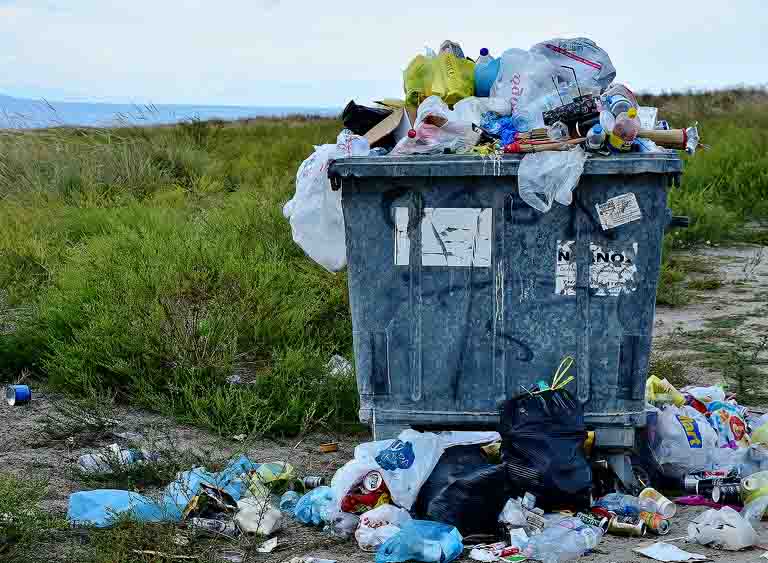
Shouldn’t we go back to avoiding the use of plastic bags? They remain one of the most pernicious sources of plastic pollution in Orillia, across Canada, and across the Earth.
Several jurisdictions around the world have banned disposable plastic shopping bags. The town of Leaf Rapids, Manitoba banned plastic bags in 2007. Several American cities have, as well. The states of California, Connecticut, Delaware, Hawaii, New York, Oregon and Vermont have done so, as have states in Australia and India. Several countries like Italy, China, Bangladesh, Rwanda, Kenya, the Congo and South Africa have totally banned disposable plastic bags.
If other jurisdictions can take this action surely we here in Orillia, and in Canada, can do the same. Isn’t it time we reduced plastic packaging in Orillia, or banned it altogether? While the government of Canada has announced all single-use plastics will be banned by the end of 2021, surely we can start now as a personal step.
Sustainable Orillia’s Youth Council will soon be launching its Boomerang Bags campaign, re-usable shopping bags made by students from recycled fabric. Watch for their instructional video on making your own, or look for them for use-and-return at shopping outlets near you.
ON THE ROAD AGAIN
After four months being sequestered, the prospect of getting out on the road for a day trip is very tempting. As current restrictions are gradually eased, in combination with careful planning and common sense, more of us will venture out for a drive in the country, perhaps for a picnic or a simple day trip to a nearby destination.
As much as we at Sustainable Orillia would prefer that every outing be emission free, most of us are more than likely going to use our vehicles for these outings. So here are a few tips to stay safe and help keep our fuel efficiency as high as possible.

- Before leaving ensure your car maintenance requirements are up-to-date and that fluid levels are all topped off.
- Have a plan. Health officials continue to be cautious about people travelling between communities, so if you’re planning to get out and walk around, it’s best not to stray too far.
- Don’t take anything you won’t need or use during the trip. The extra weight and/or any drag caused by roof or bicycle racks will add to the amount of fuel you’ll need.
- Ensure that your tire pressure is at the correct level
- Fill up with the recommended fuel type for your vehicle, and if you can do so, early in the morning. Why? Because you’ll get marginally better fuel efficiency when gasoline is at its coolest and densest first thing in the morning.
- After you’ve filled up, ensure that your gas cap is on tight.
- Be prepared. During this period of pandemic precautions it’s more important than ever to be self-reliant and ready to change a tire, top up fluids or boost a battery en route (just in case).
- Out on the road, maintain a steady pace and keep to the speed limit. It’s well known you’ll realize greater fuel efficiency driving at a steady pace rather than at higher or varied speeds.
- And finally, avoid prolonged idling. Today more cars are outfitted with automatic shut offs while we wait for lights, etc. However, if your car doesn’t have that feature and if you will be stationary for more than 30 seconds, it’s a green and good practice to turn off your car and restart when you’re ready to go.
These are just a few tips to help you and your passengers enjoy a greener ride. Enjoy your travels this summer and thank you for taking time to keep your carbon emissions as low as possible. Be sure to wave at folks as you enjoy the ride. Stay safe.
ONLY YOU CAN HELP GOVERNMENT FOCUS
Writer BF Nagy’s book, The Clean Energy Age: A Guide To Beating Climate Change presents readers with a variety of actions each citizen can take to reduce greenhouse gas emissions (GHGs). At the same time, he points out reductions in some GHG emission sources will need to be mandated by governments.
What’s our role? As citizens we must raise our voices to call on governments to tackle major sources of GHGs – and the time to do so is now.
Three of these sources are power plants, buildings and transportation are among the main sources of GHGs on the planet.

- POWER PLANTS In Ontario, we are relatively lucky because coal is no longer used to produce energy in the province. In addition, we have a relatively strong source of hydro-electricity in Niagara, and our nuclear energy plants are not emitters of CO2. Here in Orillia, we can thank the far-sightedness of those who between 1902 and 1950 built dams for the production of hydro power for our community. Thank you, Orillia Water, Light and Power. Across Canada however, coal is still used extensively. In addition, Ontario still depends on gas plants which, though an improvement over coal plants, continue to emit CO2. Further, the spent fuel from nuclear plants remains a problem in terms of safe disposal, and there is growing indication that nuclear power is a more expensive energy than that produced from competing alternative sources. Action is needed.
- BUILDINGS To reduce emissions from buildings, retrofits of older building stock are needed, and these will require investment by homeowners, business owners, and by governments at all levels. The good news however, is these investments will not only reduce emissions, but also reduce energy use. This means reduced energy bills for homeowners, businesses, and governments. Another bit of good news is the technologies to do these retrofits are currently available – whether it’s in the form of improving building envelopes, switching to cleaner, efficient heating and cooling, or installing energy recovery systems. Even more good news, many homeowners will recover the costs of retrofits in just a few years with reduced electricity bills.
- TRANSPORTATION Transportation is the source of an estimated 25% of emissions in North America. Electrification of our personal vehicles, transit, and trucking fleets will take time, but will result in immediate reductions in generated emissions. A charging network across the country is needed, as well. More good news is Canada has companies which are producing electric vehicles, so a decision by governments to move in this direction will produce jobs for Canadians while combatting the climate crisis. That’s a win-win.
Large-scale changes like these – changes which need to take place in the next decade – require governments at all levels to take action. If we want these changes to occur, we must let our political leaders know that we expect they will take action to make these changes. We must let leadership in Ottawa, in Toronto, and right here in Orillia know we support aggressive action to reduce GHG emissions by 2030. Speak up. Speak out. Let our voices be heard. Every voice counts.
STOP URBAN SPRAWL
The population of Simcoe County is 305,516 people. Ontario’s Growth Plan of 2006, and revised in 2017 sets Simcoe County’s 2031 population target at 416,000 excluding Barrie and Orillia. There is enough land currently zoned residential to accommodate 165,651 more than the provincial 2031 target – Simcoe County could accommodate 581,000 people.
However, it turns out people are not moving to Simcoe County as expected. The Ministry of Finance now projects the 2041 Simcoe County population will be 99,000 fewer people than the growth plan’s target for the same year. Given this new projection, there is no justification for rezoning more development land in Simcoe County. There is far more land zoned for residential uses than needed.
But Simcoe County does need more green land. Green lands are primarily forests and wetlands and the buffers around forests, wetlands, lakes and rivers which make up Simcoe County’s natural heritage system. Wetlands and forests provide us with free ecosystem services. They regulate water flow, filter water and remove some contaminants, help to control flooding, and provide wildlife habitat and recreational opportunities.
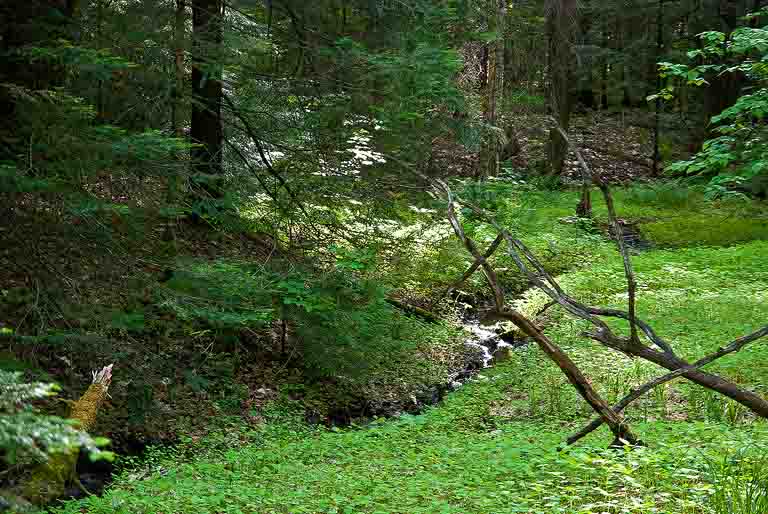
Forests also store carbon, create oxygen, provide habitat for pollinators and wildlife, and are an essential part of outdoor, sustainable recreation opportunities. Healthy, naturalized shorelines and river banks provide habitat for fish and bird prey species, in part by shading and cooling the water. And natural shorelines with trees or shrubs erode less than a bare shoreline. This is beneficial for our lakes since soil erosion contributes to phosphorus pollution.
Overbuilding unnecessarily destroys green spaces and threatens our communities’ well being. Environment Canada recommends:
- A minimum 10% wetland cover
Simcoe County has 14% wetland cover. Despite the relatively good-looking number, Simcoe County is losing wetlands. Many sub-watersheds are below Lake Simcoe Regional Conservation Authority watershed-wide targets. Sub-watersheds are areas draining into a river which then drains into a main receiving body of water such as Lake Simcoe.
- A minimum 50% forest cover
A minimum 50% forest cover is needed to support most of potential species and healthy aquatic systems. Simcoe County has 22% forest cover – nowhere near the target – and forests are being lost. Forest cover is not evenly distributed across Simcoe County, with most cover in the north.
- Less than 10% impervious land cover
Urban watersheds should maintain less than 10% impervious land cover (e.g .parking lots) in order to preserve the abundance and biodiversity of aquatic species. Simcoe County is 8% urbanized. Effort should be made to increase residential density within existing settlement boundaries and developing complete communities, thereby limiting the need to convert more agricultural and natural lands to residential.
Landowners wanting to protect environment or farm qualities of their lands forever can do so through land trusts, which are charitable organizations committed to permanent protection of lands with ecological, scenic, historical, agricultural and recreational values. The Couchiching Conservancy is a local land trust in Orillia.
SHOPPING LOCAL IS GOOD FOR THE PLANET AND GOOD FOR THE COMMUNITY
COVID-19 has really changed our habits over past weeks. For example, many of us may have decided to “order in” rather than venture out to stores and restaurants. Congratulations to all of those in our community who made the decision to support local businesses by ordering deliveries of food, meals and other necessities from our own Orillia merchants.
At the same time, while staying at home, many people will have made the decision to order things online – clothing, electronics, furniture, and things other than food that we use daily. Large, multinational companies have led the way with online offerings. More and more sources of everything are to found online. While this convenience may be tempting, please consider the negative aspects of buying products in this way.
First, all of those goods are packaged and sent to you via UPS or some other courier company. You want the item you ordered, but what about the styrofoam, plastic wrapping and cardboard that were used to get that item to you? And then there’s emissions from delivery trucks delivering those items to homes of people choosing to shop online.
And what happens if the shoes don’t fit, or you don’t like he colour of the blouse or shirt when you have it in your hands? Yes, the company will take the item back in most cases, but once again the delivery truck has to come to pick it up and take it back to the company. More emissions.

The biggest drawback of shopping online however, is one less obvious – in most cases you’re not buying from a local business.
Many of us find Orillia a wonderful place to live. Our friendly downtown and many cultural activities and sports taking place provide us with a living space that is truly welcoming – a creative space, a creative place.
A place where service clubs like Rotary, Kiwanis, and Lions work to provide help for the vulnerable in our community, where the community supports our local hospital, hospice, the Sharing Place Food Bank, the Salvation Army, Big Brothers Big Sisters, the Lighthouse Shelter—and so many other essential services.
What we might forget is the huge role local businesses play in the social and cultural richness of our community and in the compassion found in our community. Few of the things we take for granted about Orillia would exist if not for the generous financial contributions of local businesses. In contrast, most money going to online companies does not come back into our community.
Yes, Sustainable Orillia is urging you to consider a “new” normal which will help our planet. But that new normal also needs to have us return to supporting local businesses. Shop local and support the businesses which support our community.
WHERE’S THE MEAT?
More and more food outlets across Canada – grocery stores, Subway, A&W – are featuring plant-based protein options. The National Research Council predicts that, by 2024 alternative proteins (e.g. lentils, beans, tofu) will make up a third of all the protein we buy in Canada.
A Dalhousie University study found that most Canadians have considered reducing the amount of meat they eat, and that 32% of us intend to cut back in the next six months. “The momentum is building”, says Maria Ricupero, a registered dietician in Toronto, in a Chatelaine article.
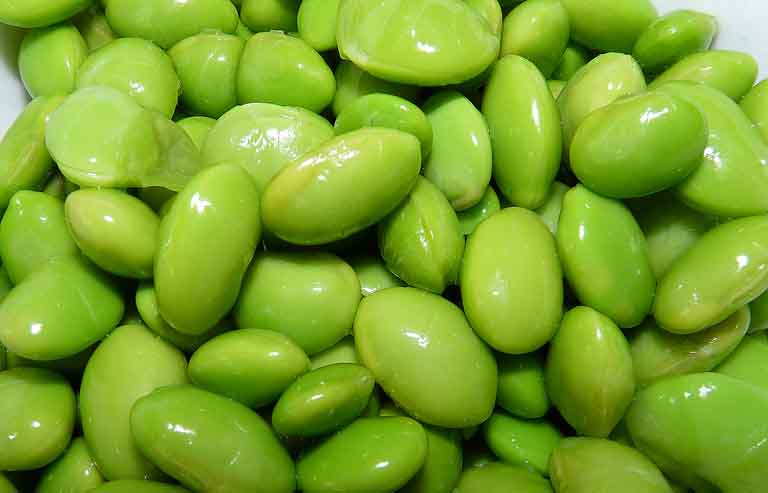
Plant-based eating is becoming more popular for two good reasons: first, it’s a way to improve our health; and second, it’s an important step in tackling the climate crisis. Producing food accounts for nearly a quarter of the world’s greenhouse gas emission – more than all our cars, planes, trains and ships combined.
A report published in the prestigious medical journal The Lancet concluded that diets with fewer animal-sourced foods and more plant-based foods are not only better for the environment but also better for our health. Vegetarians tend to have lower blood pressure, lower cholesterol levels, are less likely to develop Type 2 diabetes and some types of cancer and heart disease, and are less likely to be overweight or obese than those who eat meat.
Meat, especially red meat and dairy, have a huge impact on the planet. Grazing animals take up a lot of land. Animal farming is a major cause of deforestation. Furthermore, animals need a lot of water; one-third of our freshwater goes to animal agriculture. Then there’s the methane factor. A typical cow emits 100 kg of methane (a major greenhouse gas) every year.
According to a study co-led by Oxford scientists with data from 40,000 farms in 119 countries (published in Science),
“Cutting out meat and dairy is the single best thing most people can personally do for the earth.” They compared getting calories from meat to getting energy from coal.
An independent, non-profit collaboration of 37 scientists from 16 countries researched the optimal diet for both health and sustainability. They recommended eating around five servings of meat a week, including eggs, chicken and red meat, and one to two servings a day of dairy products. That may sound like a lot, but the average North American eats more than six times that much red meat per week and more than one-and-a-half times as much dairy.
If you choose to cut meat out of your diet, experts advise, do it gradually. And don’t forget to replace it with high-quality alternatives such as lentils and tofu. If you change your diet slowly, you’ll be more likely to make the changes permanent.
WORKING FROM HOME MITIGATES CLIMATE CHANGE EFFECTS
In an article for the CBC, Emily Chung found one of the responses to the COVID-19 pandemic – working from home – could be one of the weapons in the battle against the climate crisis in Canada and elsewhere. Companies employing hundreds of thousands of people working from home could help Canada reduce its annual greenhouse gas (GHG) emissions

For example, if the four-million-plus people in Canada whose jobs could be done from home did so twice a week, it would remove the equivalent of 385,231 cars from the road and cut annual greenhouse gas emissions by 1.9 million tonnes, according to a 2011 report from the Telework Research Network commissioned by the City of Calgary.
“There’s no quicker, easier, cheaper way to reduce your carbon footprint than not drive,” said Kate Lister, lead author of the report. Transportation is a major contributor to greenhouse gas emissions in North America, and a lot comes from commuting.
In the longer term, lower emission savings can be greater as telework policies allow companies to reduce the amount of office space they must heat, power and equip. Many cities, like Calgary, Vancouver, Saskatoon—and even smaller communities like Halton Hills in Ontario—include telecommuting in plans to reduce climate change.
Telecommuting infrastructure also instills resilience against more frequent extreme weather because of climate change. Its part of the climate change adaptation plans for cities such as Waterloo, Ontario.
Enabling telework isn’t necessarily simple. It means buying and configuring equipment like laptops, enabling secure files and resource access in the cloud, and training. “The biggest thing is training managers to manage by results rather than butts in seats,” Lister said.
On the other hand, employer benefits can include cost savings, higher productivity, fewer unscheduled absences, better employee retention, and greater flexibility to scale up and scale down when required.
Lister noted that, up until now, telework has been growing slowly and steadily at about 10 per cent a year. But COVID-19 could be a tipping point. “This coronavirus is going to leapfrog the trend,” Lister said.
SHORING UP OUR LAKES
Lakes Couchiching and Simcoe’s shorelines frame our city with an attractive waterfront which supports year-round activities, attracts visitors, provides clean water and enhances the character of our town. With all these benefits comes the responsibility to protect our lakes and their shorelines as a critical legacy for generations to come.
This week’s tip is to remind those of us fortunate enough to live right on the water’s edge—a hard-earned privilege which comes with first-hand accountability—to ensure that that our beautiful shorelines and lakes are protected.
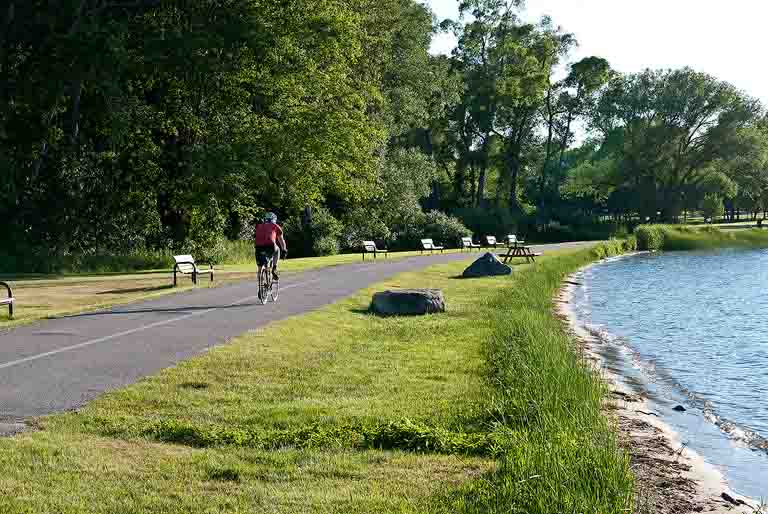
Shorelines, or Riparian areas, are vital to the health of lakes. Here are some points to keep in mind which will make a positive difference to the health of our lakes:
- Preserve the existing natural shoreline vegetation, particularly if it’s mature. The goal is to leave 75% of the shoreline natural, creating a buffer that binds the soil and minimizes erosion. The presence of healthy, vegetated buffers along our shorelines will save habitats, soil stability, and land.
- Be a bioengineer. Keep the vegetation diverse and choose deep-rooted shrubs or trees like willows and dogwood as part of the natural buffer. And make the buffer as wide as possible.
- Ensure that boat wakes are kept to a minimum. Signs reminding passing boaters to slow down will be helpful.
- Avoid the use of fertilizers and pesticides that may run off into the water. Ensure that any rain gutters or drains are diverted away from the shoreline.
- Cut or leave your lawns longer to enhance the water-holding ability of the soil along the shoreline.
- Protect any streams that flow through your property to the lake. Keep streambeds and banks naturalized and unimpeded.
- Minimize paved areas close to the shore, so as to keep run-off to a minimum.
- Where possible, cultivate or encourage shade along the shoreline. This will moderate the effects of climate change, particularly slowing evaporation in shallow waters.
- Check with your local conservation authority (or the responsible Municipal, Provincial [MNR] and/or Federal agencies for your location) to ensure you have consulted and have all the necessary permits when planning any work near a lake, river, stream or wetland on your property.
If you would like to know more about how to protect our lakes and their shorelines, there are a number of organizations dedicated to the conservation of both lakes and a myriad of resources available to help any property owner interested in either restoring or protecting their piece of the shoreline. Among these are the Rescue Lake Simcoe Coalition, the Lake Simcoe Region Conservation Authority and the Couchiching Conservancy.
You don’t have to own a waterfront property, we all share responsibility and stewardship for keeping our beautiful lakes healthy. Sustainable Orillia encourages all interested parties to get involved.
COAL IS PASSÉ, ALMOST
A recent New York Times article by Brad Plumer announced, “the United States is on track to produce more electricity this year from renewable power than from coal for the first time on record…”
“It is a milestone that seemed all but unthinkable a decade ago… the cost of building large wind farms has declined more than 40 percent in that time, while solar costs have dropped more than 80 percent. And the price of natural gas, a cleaner-burning alternative to coal, has fallen to historic lows… ”
“In just the first four and half months of this year, America’s fleet of wind turbines, solar panels and hydroelectric dams have produced more electricity than coal on 90 separate days—shattering last year’s record of 38 days for the entire year. [The decline in coal usage] has already helped drive down United States’ carbon dioxide emissions 15 percent since 2005. This year… emissions [are expected] to fall by another 11 percent, the largest drop in at least 70 years.”
“The grid is changing so much faster than anyone expected,” said Daniel Cohan, an associate professor of civil and environmental engineering at Rice University. A decade ago, I was teaching my students that coal was the baseload source that runs all the time. Now.. it’s wind and solar that are the cheapest options.”

Plumer writes, “At the same time, electric companies used to worry that using more than just a tiny fractions of wind and solar would make it difficult to keep the nation’s lights on, since the sun isn’t always shining and the wind isn’t always blowing. But since then, utilities have discovered ways to tackle this problem by using technologies like natural-gas plants that can be quickly turned on to meet spikes in demand, better weather forecasting and, increasingly, vast battery storage projects such as those planned in Nevada and California.”
The author of the story also notes that Great River Energy, a cooperative based in Minnesota, plans to close its giant Coal Creek Station in North Dakota by 2022. “The utility plans to add 1.1 gigawatts of new wind capacity, a small amount of gas, as well as a first-of-its-kind battery that can store wind power for long periods.”
“In some parts of the country, we’re now seeing renewable penetration hit 60 or 70 percent on some days,” said Nat Kreamer, chief executive of Advanced Energy Economy, a clean energy business group, “and no one’s screaming that they can’t do that.”
Ontario, too, has had its share of naysayers in regard to the effectiveness of alternative energy sources. But Ontario has eliminated coal plants. The U.S. example suggests we can do even more to harness wind and solar going forward. And Canadian provinces that are still clinging to coal-plants to produce energy clearly have lower-cost alternative sources that are not only viable replacements, but clean, non-greenhouse gas sources of electricity.
What can we here in Orillia do to support the move to cleaner energy sources? Four things come to mind:
- Support locally owned renewable energy projects (for example, the proposal to put solar panels on the new Orillia Recreation Centre roof)
- Invest in energy efficiencies and retrofits for homes and businesses (which also creates jobs)
- Urge the city to electrify transit, and
- Encourage friends and family to buy electric vehicles.
WRAP IT UP
We’ve become accustomed to plastic packaging in much of what we buy – especially in the grocery store. So much of our food is wrapped in plastic. For example, how can we buy frozen foods and cooking oil without it? Zero-waste grocery shopping seems a distant dream.
But some folks Who responded to the CBC’s What On Earth? are finding ways to make their shopping more plastic-free.
Wendy Jeske in Tsawwassen, B.C. says: “I have been buying meats from the butcher counter, so that they are wrapped in paper (as my mother used to do!), rather than buying meat that is placed on a plastic tray and wrapped in plastic film.” Jeske gets her eggs “from a local farm and they want the cardboard cartons only, so I keep returning them to the farm. No styrofoam or plastic cartons! Yay!”
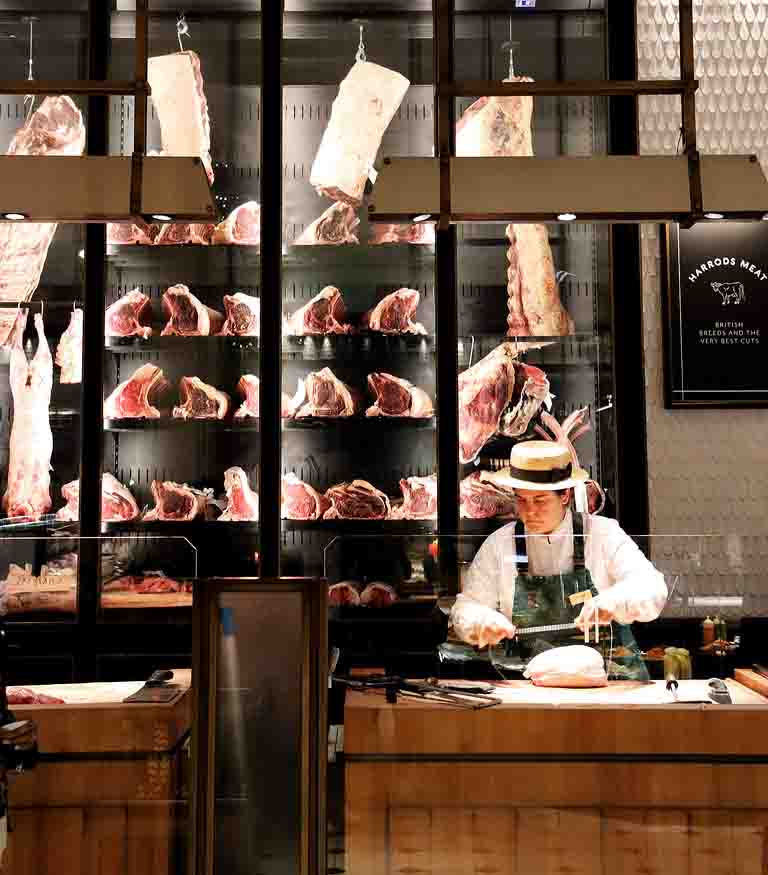
Catherine Irwin-Gibson in Montreal said her fishmonger gives her “a 15 per cent discount for my own container, and just zeroes the scale with my container on it, then prints the label for the cost. Yes, there is a label and that’s the waste, but it’s much lower than the whole packaging and styrofoam and such nonsense like that.”
Irwin-Gibson even has an idea for frozen food. “Buy [produce items] fresh when they’re in season and freeze them yourself.”
How about bread? “I dusted off my bread machine and I make my own,” said Marcia Parker.
Kiirsti Owen in Truro, N.S., said she brings her own growler (large bottle) to local breweries to get beer and cider. She also put in a plug for the SodaStream home-carbonization system: “I was skeptical at first, but it’s greatly reduced the number of bottles/cans we use.”
Kaitie Hoffmann in Toronto rhymed off a list of things she has “successfully gotten package-free: meats (bacon, chicken breast, ground meat), cheese, milk, yoghurt, sour cream, cream cheese, bacon, breads, fresh and frozen veggies and fruit, oils (olive, etc.), spices, pasta, oatmeal, potato chips, honey, crackers, tortilla chips, peanut butter, chocolate bars, coffee, tea… you name it.” She accomplished this, she said, by bringing her own containers to bulk and grocery stores.
Alex Denicola has “completely eliminated plastic bottled liquid soap for both dishes (hand-washed) and the bathroom sink and shower for over 10 years now. We use both a ‘laundry bar’ soap and a ‘shampoo and conditioner’ bar soap made by a Toronto company, and they awesomely come with zero wrapping. What we do in the kitchen is simply run or pour hot water over the soap bar, and voila, we have a sink or basin of sudsy water.”
Some say that it’s hard to go zero-waste outside of Canada’s urban centers.
Julie Poole in Swan River, Man., wrote, “even though [zero-waste shopping] is possible in big cities like Toronto and Vancouver, it is actually totally impossible in rural Canada.” She said she wrote in “to voice my frustration that I want to do better, but the things I need are not available where I live. No bulk foods and no butcher.”
Kaitie Hoffman offered this parting insight: “I have heard that ‘it’s not about a small group of people doing this perfectly, it’s about a large group of people doing this imperfectly.’ I think that is an amazing message that hopefully will resonate with your readers and beyond. It’s not about going 100 per cent plastic/packaging-free – it’s about avoiding single-use plastics and other packaging where you can.”
Orillia, we are lucky to have zero-waste food options. The Refillery District (18 Mississaga St. E.) and Bulk Barn (3275 Monarch Drive) are just two examples.
NOT THE DIRTY DOZEN
There are twelve things you can do to keep the planet fit for human life. Reducing GHGs, garbage and pollution means big structural things need to change, the drive to change will likely require lots of individuals acting greener – and then demanding the same from our policy makers.
For example, each of us can:

- cycle, walk or take the bus instead of driving, whenever it is an option
- fly less
- buy fewer things that have been imported
- eat less meat
- boycott companies actively damaging the environment for profit
- avoid products with excessive packaging
- avoid going on cruises
- avoid single use plastic, or leave it at the store
- buy local
- pick up litter
- patronize thrift shops
- vote
There is no question changing structural elements of the global economy will have more of an impact than any individual’s actions. Still, being conscientious about our individual choices can be the precursor to those structural changes.
Green alternatives can be, or may become, cheaper than current practice. Individual green consumer habits may alter what the market offers. Greener habits will hopefully translate into greener voting patterns, which will enable policies to exert pressure on industry to reduce carbon emissions. Let us be the change instead.
PLANNING A POLLINATOR GARDEN
It may seem hard to believe, but spring is just around the corner and there’s no better time than now to get organized and plan your garden for the summer months ahead. Thoughts of sunny days and beautiful gardens will warm us up. A vital part of that vision includes birds, bees, butterflies and other pollinators dancing from one flower to the next, spreading all-essential pollen.
We need pollinators like bees, beetles, butterflies and, yes, even flies — to protect our primary food source of fruits, vegetables and field crops. Some 80% to 95% of all plant species require some form of pollination and creating a pollinator garden is one way we can help the balance of nature do its magic, at the same time ensuring humans of a continuing, affordable food supply.
A pollinator garden is designed and planted with specific nectar and pollen producing plants in a way to attract pollinating insects. Some guidelines to create a pollinator garden include:
- Use local plants,
- Design with blooms and diverse species that will bloom in sequence, all season long,
- Plant in bunches of 5 to 9 plants or more,
- Avoid double-bloom varieties. The extra petals, although pretty, can be a barrier for pollinators,
- Stay pesticide free – consider ladybugs as a natural pesticide alternative,
- Plant milkweed for Monarch butterflies
- If your garden permits, leave a section undisturbed, unmulched, and unwatered for those insects who live in the ground, which includes 70% of our native bees.
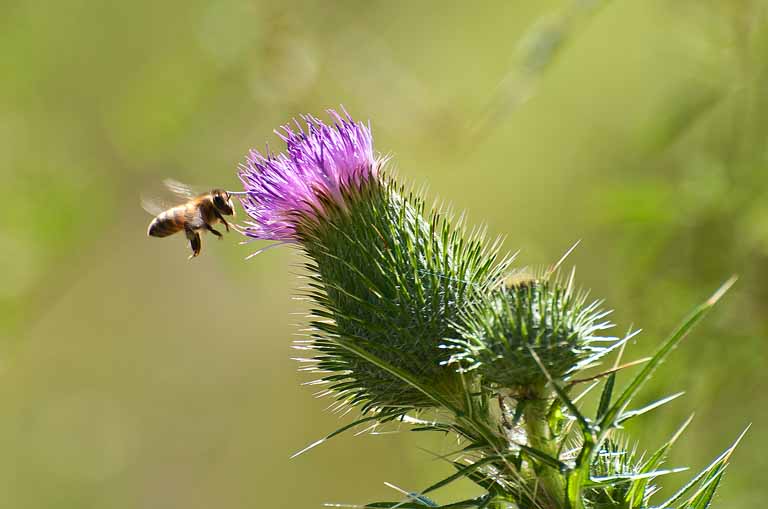
Recommendations for annual and perennial flowers to plant in your pollinator garden or hanging basket could fill this page and several more. Orillia’s Hardiness Zone is between 4 and 5, which supports a lot of diversity and choice for your garden.
Our local nurseries, plus the City of Orillia Parks department, are the best source of advice and experience to help you plan your pollinator garden.
And for those of us who either don’t have a garden space or who would simply rather visit a garden then cultivate one ourselves, the City of Orillia has over 70 annual and perennial gardens, including two butterfly gardens and two community gardens, all of which have pollinator species planted throughout. On a smaller scale, flower baskets, like the ones hanging throughout the downtown core, also provide nectar for pollinators.
Taking action to support pollinators helps protect the balance of nature and the future of our environment. It contributes directly toward a sustainable quality of life for us and our grandchildren down the road. The more we get out there and help birds and the bees weave their magic, the better it is for us all.
GROW YOUR OWN
One of the best and most delicious ways to make your garden eco-friendly is to grow some of your own food. Much of our produce is imported from other countries for most of the year. By growing some of your own veggies, herbs, and berries you’ll decrease reliance on food delivery systems and decrease emissions from large-scale farming, storage, refrigeration and transportation. You’ll also have less lawn to mow.
Green vegetables like kale are easy to grow. Perennial berry plants like blueberry bushes and raspberry canes are also excellent producers for the home garden. Fruit trees such as apples can handle cold winters and the fruit can be stored for months in a cellar.
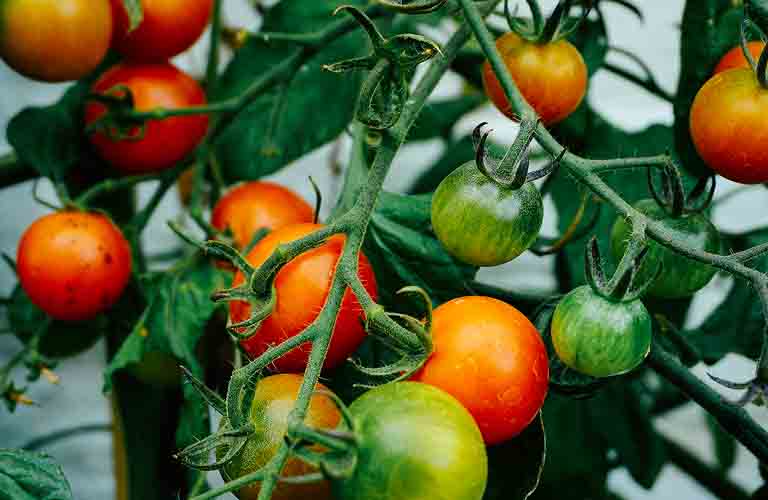
Garlic is quite easy to grow at home, and is much healthier and more flavourful than imported garlic. Garlic can be planted in the fall or early spring. The scent of garlic growing has the added benefit of organic pest control – many pest insects simply don’t like the smell.
Stop using chemical fertilizers in your garden (hint – if it’s a bright colour, it’s probably not organic). Also, stop using potting soil containing chemical fertilizer or pesticides. Nitrogen and phosphorus pollution from chemical fertilizers is now considered a major environmental concern.
If you want your garden to be eco-friendly, it pretty much has to be organic. Organic gardening foregoes harmful chemicals like pesticides, herbicides, and fungicides in favour of working with nature to create a healthy eco-system. There are many online resources to learn about organic gardening.
What could be fresher than veggies and fruits grown just outside your door? Or even inside your house? You’ll save money too.
HOW TO HELP BIRDS AND BATS
At Sustainable Orillia, our goal is to help make our community one in which those generations that come after us inherit a world that is equal to or better than our own in terms of the environment and life’s opportunities. A worrisome note being sounded these days is about the loss of bird species across North America, and a disease is killing bat populations.
Reductions in bird species and bats are not just a question of lost birdsongs and no more bats in the backyard. Birds and bats, like butterflies and bees, are insect eaters. According to the latest edition of Canadian Wildlife magazine, bats eat vast amounts of agricultural pests, saving farmers billions of dollars.
Sustainable Orillia has already published a tip about planning and planting a pollinator garden (scroll down) which contains brightly coloured flowers for the bees and some milkweed for the Monarch butterflies. This week we focus on what each of us can do to help our birds stay healthy (with thanks to the Canadian Wildlife Federation’s publications).

Provide nesting materials for birds as they return to our area. “Redwinged Blackbirds, Common Grackles, Eastern Phoebes, Barn Swallows, American Robins and Wood Thrushes all use mud and a variety of other construction materials in their nests. These may be in short supply in some locations. Offer up chemical free grass, pine needles, twigs, moss and leaves to help them line their nests.”
Build a bat house for female bats seeking maternity roosts to raise their young between May and July. A bat house needs a sunny spot, at least 8 hours a day to keep the young warm. It needs a nearby source of water and needs to be out of a predator’s reach on a pole or a building at least 3 meters from the ground. Also, keep it far away from light pollution from outdoor lighting or streetlamps. The bonus? Watch them dive and swoop as they track and eat mosquitoes on warm spring and summer evenings as you sit out on your porch.
You can help the Canadian Wildlife Federation and other wildlife organizations track biodiversity in our area. Go to www.CanadianWildlifeFederation.ca or email info@cwf-fcf.org for more information.
A RECYCLING REFRESHER FOR THE HOUSEBOUND
In response to the COVID-19 outbreak the City of Orillia recently announced people will be able to put out one garbage bag each week without a tag, recognizing households now have families at home and will be eating more together and therefore producing somewhat more waste.
Sustainable Orillia would like to urge citizens to pause – before using that extra garbage bag – to first consider whether your family is doing all it can to divert materials from the waste stream. Don’t forget to reduce, repair and re-use to begin with. Our Tip of the Week this week is a reminder of what can be recycled and what can be composted, and a reminder, too, only materials that cannot be recycled or composted should go into a garbage bag.
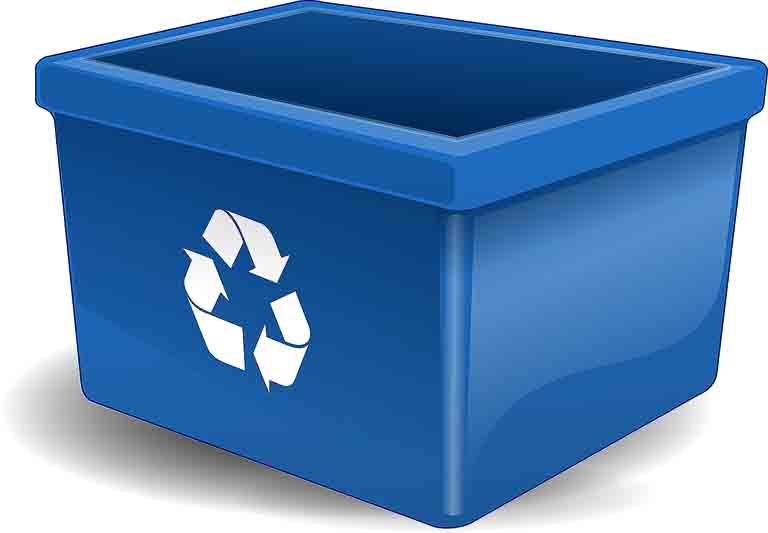
In thinking about this, why not involve everyone in the family, including the kids? Create a game (Spot the Recyclable? or Save the Compostable?). Find games online here and here.
For city programs to work well, everyone in the family has to participate. Lists below are based on City of Orillia. In general, to recycle effectively your home should have two blue boxes, one for paper and one for containers.
PAPER: newspapers, phone books and catalogues, magazines and junk mail, wrapping paper (no foil), office paper, envelopes (without windows), paperback books, cereal boxes (flatten), paper egg cartons, small pieces of cardboard, paper towel and toilet rolls, empty paper cups, empty cigarette packages. Place styrofoam packaging and trays in a bag and place plastic shopping bags, milk bags and bread bags (clean and empty) in another bag, tie at top, and drop it into this blue box.
CONTAINERS: milk and juice cartons (rinse first), drinking boxes (empty), food and beverage cans, clean foil and trays, empty paint cans (<4L), empty aerosol cans, frozen juice cans, all plastic containers with caps on (codes 1, 2, 4, 5, 6, 7), plastic tubs and lids, yogurt containers, empty plastic clamshell food trays, glass bottles and jars. Rinse to remove food or juice remnants is necessary.
The City of Orillia is doing a great job removing a large quantity of items from the waste stream through the recycling and composting programs, but they only work if its citizens do their part in the process.
COMPOSTING: cooked meat, chicken, fish and bones (to clarify: raw meat trimmings and meat in small quantities gone bad can also be disposed of in the green bin, but raw meats can, of course, cause odor problems – thus the City’s focus on cooked), dairy products (no meat or dairy packaging), soiled paper towels, tissues, paper food packaging, waxed paper, plants, dryer lint, eggs and eggshells, fruits and vegetables, corn cobs and husks, nuts and shells, coffee filters and grounds, tea bags, salads and dressings, rice and pasta (cooked or uncooked).
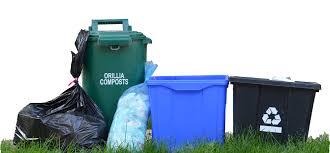
To reduce moisture and smell, wrap food scraps in two or three layers of newspaper or use certified compostable bags in your kitchen. If using bags, tie tops before placing in the larger green bin for collection. (CORRECTION: an earlier Sustainable Orillia Tip of the Week said that “biodegradable plastics” or “compostable plastic” could be dropped into the city’s composting bins. Acceptable bags must say “certified compostable” to be accepted by the City for composting)
If all of the above items are placed in the correct recycling box or composting bin, what is really left behind to put into a garbage bag? Not much.
______________________
Need a Recycling Box or Green Bin?
In normal circumstances, Orillia residents and businesses can get a recycling box and a green bin at the waste diversion site located at 100 Kitchener St. Recycling boxes can be purchased for $5 each (both regular and large size). Green bins can be purchased for the subsidized price of $15. Smaller kitchen organics containers can be purchased for $2 each. Broken recycling boxes, green bins, or kitchen containers are exchanged free of charge. New residents can receive up to two recycling boxes, one green bin, and one kitchen container at no charge. Photo ID is required. New residents who are renting must show proof of a new rental agreement with photo ID. Otherwise, you can purchase the bins at the applicable rates.
Right now the diversion site is closed to the public. If you don’t have a blue box, place recyclables in a clear plastic bag on pickup day. If without a compost green bin, place compostables in a cardboard box or container labeled kitchen/yard waste. If you are new in town, call the waste diversion site at 705-325-3522 and they’ll try to help.
FASHION TIPS FOR THE CONSCIENTIOUS
St. Patrick’s Day has come and gone, but the idea of ‘greening’ our clothing choices is a good year-round practice. Over the past decade, we have become increasingly aware of the damaging effects mass textile production and apparel manufacturing have on the environment.
For example, to produce one kilo of cotton takes 20,000 liters of water, and this is on top of the agrochemicals or pesticides used during crop production. Some manufacturers are beginning to introduce and promote more eco-friendly processes, seeing the ethical and economic benefits of positioning themselves as greener sources for clothing. Sadly, the majority of producers here in North America and around the world continue to do ongoing damage to the environment during manufacturing processes.

As consumers we play an important role in breaking this harmful cycle through our purchasing habits and by how our clothing is disposed of once we are finished with it. Some studies indicate textile waste represents 5% of North American landfills. That may not seem like a big percentage, the actual numbers are staggering. Each year the average Canadian throws out 37 kilograms of textile products and across North America 9.5 million tonnes of used clothing are sent to landfill.
The following tips can help reduce that mind-numbing number. As with all of Sustainable Orillia Tips, these are small steps we can all adopt as common sense tactics to make a difference:
- Research where and how your clothing is made. Make purchasing decisions in favour of materials and manufacturing which follow environmentally friendly processes.
- Whenever possible invest in better quality and more classic styling. Stay away from high style or trend items that won’t survive more than a couple of seasons.
- Think vintage, buy your clothes with a longer lifespan in mind. Take pride in the fact that a favourite sweater can last ten or fifteen years.
- Take care of and repair your clothing. This sounds a bit obvious, but it is surprising how unmotivated we can be to simply sew on a button at times. Like our cars, when we keep clothes clean and in good repair, we enjoy them much more and much longer. If you don’t have the time or inclination, most dry cleaners can help you find a local tailor or seamstress to do the job for you.
- Follow the care instructions on your clothing to ensure they last longer.
- Where possible swap with friends and family members. Hand-me-downs are so sensible on many levels, and clothing swaps can be a lot of fun.
- Donate used items in good condition to support the second-hand market.
- Buy locally wherever possible. When you buy apparel made closer to home, right off the top you eliminate the additional greenhouse gas emissions it takes to ship products from elsewhere.
- Repurpose used clothing. Cut them up for rags or bags. Do your best to keep them out of landfill for as long as we can.
Speaking of rags and bags, the Sustainable Orillia Youth Council launched an initiative called Boomerang Bags designed to get people using re-usable bags instead of plastic. Students from our secondary schools in Orillia collected and sorted supplies of used clothing and with some ingenuity and elbow grease they are repurposing as shopping bags. These bags will soon be available for free at stores, but remember they are Boomerang Bags – customers will be asked to bring them back on the next visit to the stores.
Kudos to the creative young minds and spirits who made Boomerang Bags available in Orillia; it’s an inspirational example of how to keep our dear old clothes out of the landfill a bit longer.
PEDESTRIAN MALLS
An idea popping up in many cities around the world is to turn the downtown’s best street into a pedestrian mall. However, few people are familiar with the sobering history of this idea.

In the 1960s and 1970s, hundreds of main streets were turned into pedestrian malls. Eventually, most of them were (expensively) retrofitted back to welcoming cars again. Nevertheless, the successes are remarkable, and these exceptions are instructive. What does it take for a main street to survive without cars? You’ll never guess: stores that don’t need cars.
It works well in Europe. Most sizeable European cities have one or more main streets that are pedestrian only. Copenhagen, a northern city like those in Canada, has a central pedestrian zone of more than 25 acres. It is sometimes difficult to say how car-dependent a shop or restaurant may be. Merchants often over-estimate it. But the good news is, we don’t have to guess. We can close the street for a few days and find out.
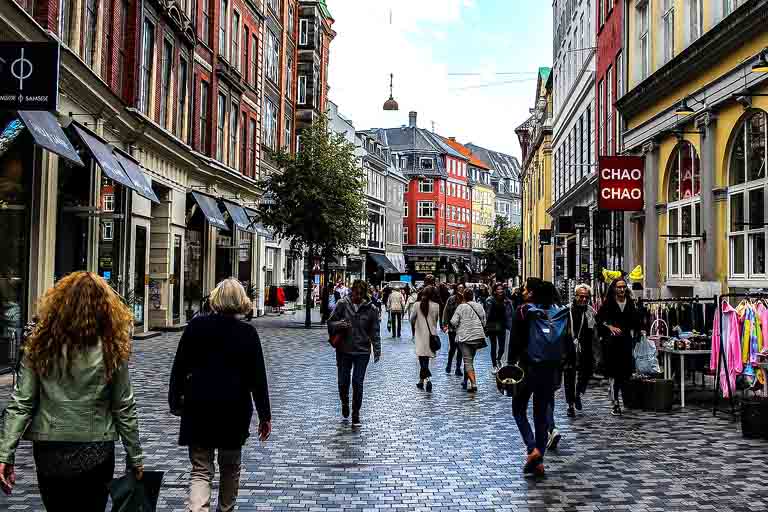
In Orillia, we have tried this already. Often in summer, we close Mississaga Street for a day or a weekend. Each success can lead to another, longer test. If we stay light and flexible at first, and don’t spend a whole lot of money on making the change permanent, we can see what arrangement works best.
Experience from other cities tells us that the success of a pedestrian zone depends more on location and access than on materials and beauty.
LOOK AFTER EACH OTHER
Coronavirus. COVID-19. Over the past few weeks these terms have become common to virtually everyone’s vocabulary around the world. And over the past week or two, we have seen our lives turned upside down by what is now recognized as pandemic—a worldwide epidemic of a highly contagious virus that is capable of killing some who catch it.
A sustainable community is not just a community which is looking forward to coming generations. It is also a community in which people care about each other now and look after each other at the present time. Orillians are already recognized as caring people. The money raised by The Coldest Night of the Year and by the many fundraising initiatives we see annually in our community demonstrates the generosity of our citizenry and indirectly the kindness and compassion that lie behind that generosity. We are a fortunate community in so many ways.
We are also a community with a higher than average number of older people living here and that should raise alarm bells for all of us during this pandemic. We are being urged to stay at home, to self-isolate in order to slow down the spread of this virus. But, there are some in our community who live alone and may not be able to ensure they have the food, medications, or other supplies they need to survive for several days or weeks. There will be many as well who will find social isolation leads to loneliness, to anxiety, or to depression.
So today’s Tip of the Week is about being aware of such people in your neighbourhood or elsewhere in our community. Here are some steps that all of us can take:

- Call your neighbour by phone. Knock on the door and talk to them if you don’t (from 6 feet away – social distancing works). See if they need anything, food pickup, medicine delivery, a newspaper or books. Volunteer to pick up things for them.
- Call family members who might live in another town. We might not be able to visit for a dinner or for a weekend, but that doesn’t mean we can’t have a conversation with them, especially if they are alone – and call regularly.
- Many of us have computers, iPads or phones allowing us to keep in touch with people easily. Facebook is a tool for keeping in touch with each other, as are other social media, but not everyone has access to these. A good old fashioned phone call will still allow contact with a person who might otherwise be feeling lonely and forgotten.
- Let’s not forgot The Sharing Place, The Lighthouse Soup Kitchen and Shelter and the Salvation Army. There are people who do not have a place to stay, do not have food in the fridge or freezer and do not have a warm house and warm blankets. Now is a time to be generous, to drop off a cheque or donate online.
These suggestions are not unique to us here at Sustainable Orillia. This is (and may continue to be for some time) a new and difficult situation for our community and for those elsewhere in our country and our world and sometimes in anxious times like these we tend to focus on ourselves and our families to the exclusion of others. We need reminding we are not alone, we are social beings, we need social interaction with people who care about us and enjoy our company – and yes, even with strangers.
More than ever, we need each other and can help each other. In a sustainable community, in our sustainable Orillia, we’ll get through this by being together even when we’re at a distance from those around us.
Take care, everyone.
ROVER AND TIGER WANT TO HELP TOO
Did you know that in Canada there are almost 6 million dogs and 8 million cats?

We love our pets, but like with humans, caring for pets can generate a lot of plastic waste that ultimately ends up in our landfills or oceans. Not a good thing.
So here are a few tips to make your pet’s lifestyle more eco-friendly:
Use stainless steel or ceramic bowls for food and water
Use biodegradable bags to pick up pet waste and add it to your compost if you can
Make or get a wooden dog house instead of a plastic cage
Look for toys made with more natural materials like bone, rubber or rope.
Comment
PHANTOM POWER
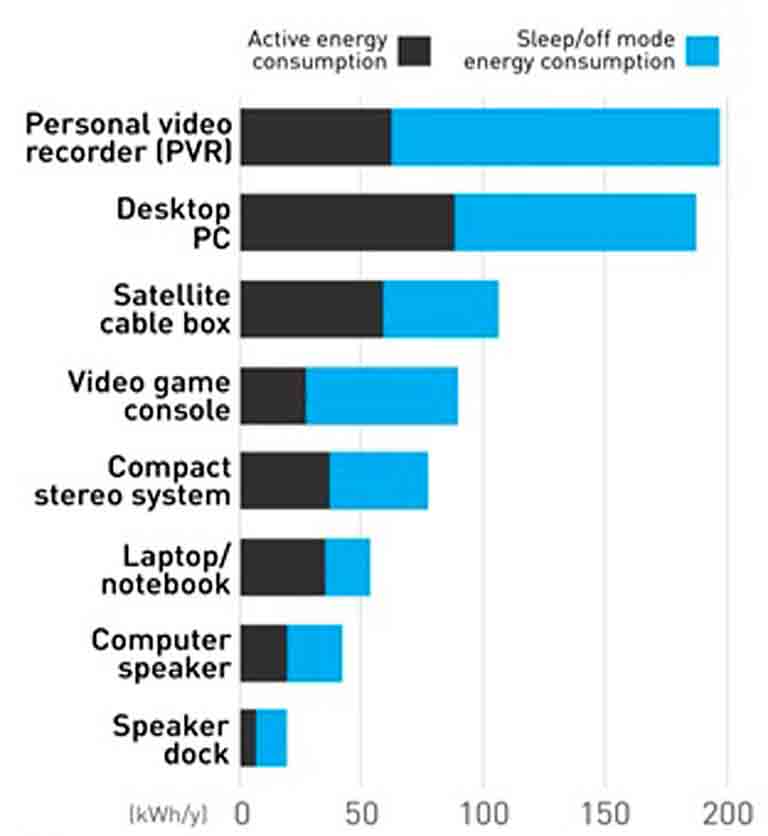
Many of our modern devices need electricity, and many of us are content to leave them plugged in all day and night. But these appliances draw electricity even when they’re not in use (so-called phantom power). According to the Hydro One, the average Canadian home contains more than 20 devices that draw phantom, or standby, power, which can account for up to 10 % of home energy use.
Fixing the problem is as simple as unplugging every appliance you own when it’s not in use, or using advanced power bars that can time out or sense when devices are idle. Here’s a look at the energy use of some typical electronic devices.
Wasted energy is wasted money and needless emissions. Can you pull the plug?
ARE ELECTRIC VEHICLES MORE EXPENSIVE?
If you just look at the sticker price, yes. But in reality the purchase price is only part of any car’s cost. Corporate Knights published an article comparing some EVs with comparable gas-powered vehicles. Their findings regarding total cost of ownership (TCO) included making a number of reasonable assumptions that included gasoline and electricity prices, kilometers driven per year, keeping the vehicle for 10 years, financing costs, and maintenance costs.

Two sets of vehicles were compared. The first set compared a 2019 Honda Civic LX and a 2019 Nissan Leaf S. After all the calculations were done, even though the Nissan was $13,028 more to buy, at the end of 10 years the Nissan made up the difference and then some – it was $2,205 cheaper than the Honda.
In another comparison of two small SUVs, a gas-powered Toyota RAV4 and a Hyundai Kona (EV), the $11,909 premium the purchaser would pay when buying the Kona disappeared. At the end of 10 years the Kona owner was ahead by $4,985.
Another study published in Applied Energy January, 2018 compared gas, diesel, battery electric and hybrid vehicles from 1997-2015 in the US, UK and Japan. The study calculated TCO using an average annual mileage for each region and an average annual maintenance cost. “Costs were found to be cheaper for electric vehicles due to less wear on the brakes and fewer moving parts,” wrote the study’s authors.
Today’s electric vehicles are even cheaper than in that study. With each year the TCO differential between EVs and internal combustion engines (ICE) vehicles will only improve. Even today, incentives or not, economics should be helping you decide in favour of buying an EV, without even considering the other clear benefits of an EV – no greenhouse gas emissions and better performance.
GOOD FOOD DOESN’T HAVE TO GO TO WASTE
When food ends up in a landfill, it releases greenhouse gases as it decays. The UN’s Intergovernmental Panel on Climate Change (IPCC) reports from 2010 to 2016 global food loss and waste contributed 8 to 10% of human-caused greenhouse gas emissions.
According to the food rescue organization, Second Harvest, 58% of food produced in Canada is lost or wasted, amounting to 35.5 million tonnes a year. Much of that could actually be rescued and eaten. But how? Well, now there’s an app for that.
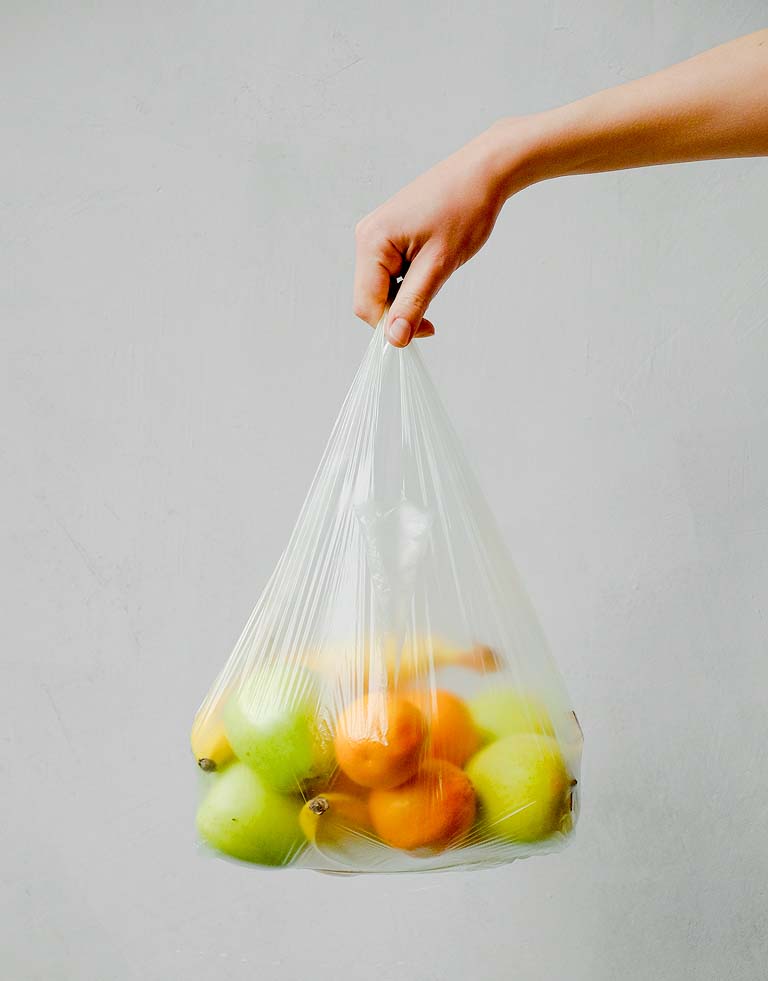
Flashfood is a startup partnered with grocery giant Loblaw earlier this year to sell surplus food at a discount, typically 50 per cent or more, at hundreds of Loblaws locations across the country (including Zehrs in Orillia). Through the Flashfood app, each store posts daily offerings, including meat, dairy, bread or packaged foods that are approaching their best-before dates.
App users shop and pay on the app, then pick up their order from a designated fridge at the store any time during the day. For example, fruits and vegetables are sold as a random, 5 pound assortment for $5.
Josh Domingues, Flashfood’s founder and CEO, said the app has more than a million downloads so far and has diverted more than 907,000 kilograms from the landfill. “It’ll actually dictate what I buy for dinner,” Domingues said.
For Toronto residents who don’t want to cook themselves, there’s another option: an app called Feedback. It offers discounts of 15 to 50% at hundreds of restaurants at off-peak times such as between lunch and dinner and at the end of the day.
The app was inspired by a pizzeria offering free pizzas at the end of the evening, saying they would otherwise be thrown out.
Flashfood and Feedback help reduce waste and greenhouse gas emissions, but also they offer a more immediate perk, a chance to save money.
THERE IS NO ‘AWAY’
Over the past several decades, we’ve prided ourselves on implementing strong recycling programs here in Orillia. Support for the Orillia Blue Box program by this community has earned top marks. However, lately we are realizing that there are many products that do not recycle effectively – and many, especially plastics, do not recycle at all.
What’s the answer? Simply, our first focus must be on reduction, using and buying less, and then on re-use and refill systems. Here are some of the myths surrounding recycling.
Myth #1: It’s recyclable
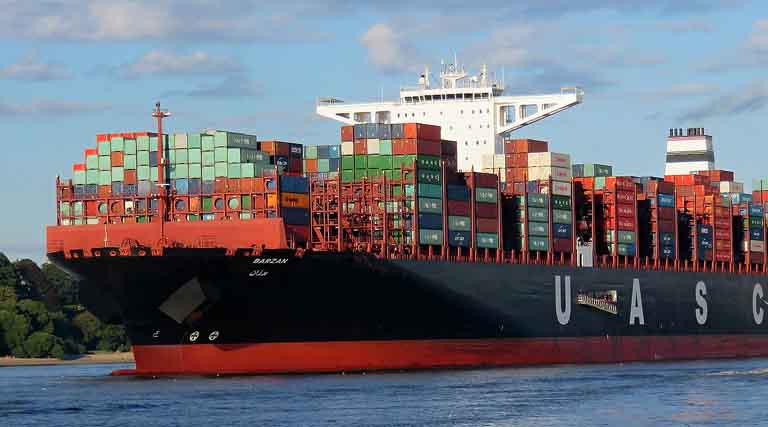
Companies are increasing their plastic production every year. Globally, however, only 9% of plastic has been recycled. Just because something says it’s recyclable doesn’t mean it actually gets recycled. The recent sight of container loads of materials sent to China and other Asian countries and the demand that Canada take them back (which we did) – makes it clear that we have yet to find good recycling solutions for many products.
Myth #2: Paper is better than plastic
Some paper is compostable, or recyclable (e.g. newspaper and fine paper), but moving to paper products just shifts the problem. Large scale deforestation for pulp to make paper emits large quantities of CO2, contributing to climate change and loss of biodiversity. Trees are needed across the planet to absorb CO2.
Myth #3: Bio-plastic is better than plastic
So-called biodegradable or compostable plastics break down only under certain industrial temperatures or pressures. They do not biodegrade in a landfill; nor do they compost. Bio-plastic may sound better, but it isn’t.
So what’s the answer? Try to buy your food and supplies at stores that are seriously trying to stop selling us throw-away packaging. Remember, there is no “away”.
THE SURVEY SAYS
Here at Sustainable Orillia, we’re marking just over four months of Tips of the Week. It’s time, therefore, for some assessment of whether they’re reaching people out in our community.
If you’re reading this article right now, we need to hear from you. We’d ask you to email your comments to us at info@sustainableorillia.ca.

Here is the type of thing we’d like to hear from you:
How often have you read the Tips of the Week? 0-5? 5-10? All of them? (we’ve published about 24 to date).
Have you been able to implement some of the tips? Which ones?
Do you feel you’ve been able to change your habits—even if just a little?
How does taking actions to reduce your waste production or your GHG emissions make you feel? Good? Better?
Are there other ideas you’d like to see us focus on in Tips of the Week?
We’d love to hear from you. In fact, we need to hear from you to determine whether our work getting these Tips published is working to change people’s habits – even if just a little bit at a time.
If you are reading the Tips and if you are trying to apply them to your everyday life, there’s one other thing we’d urge you to do, tell your friends, family and neighbours about them – and about how they are working for you.
All of us are in this together as we aim at creating a more sustainable Orillia. Thanks for what you do.
From Gord, Susanne and Fred – some of the folks at Sustainable Orillia
P.S. A tip of the hat to John Swartz (sunonlinemedia.ca) and Dave Dawson (at OrilliaMatters.com) for their support publishing our tips.
CAR WASH BLUES
Many car-owners wash their cars at home. The result is soapy, dirty water flowing down driveways, into streets and into storm water sewers that lead directly to creeks, streams, rivers and lakes. The unfiltered run-off from washing your car at home sends grease, gasoline, oil, exhaust residue, bits of rubber, and road tar into waterways, harming fish and other wildlife.
This, folks, is pollution.
Even the detergent you use might be harmful, especially if it contains phosphates. Phosphates, also used in fertilizers, affect rivers and lakes because they encourage the growth of algae, a process that robs the water of oxygen needed by other wildlife. Even biodegradable detergents can damage gills and destroy the external mucus layers that protect fish from bacteria and parasites.
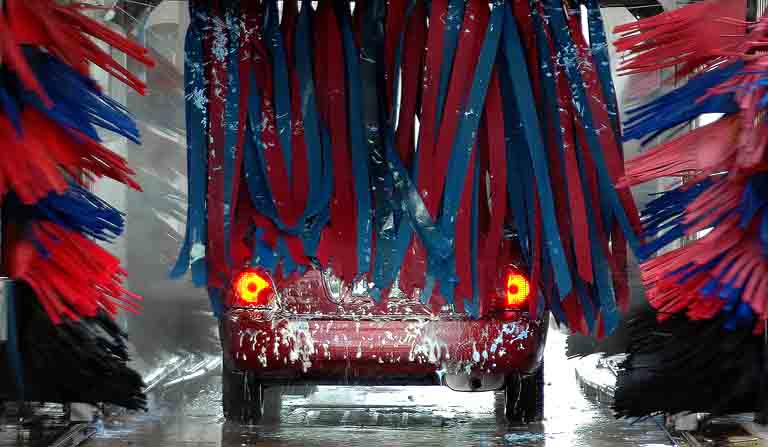
Home car washing is also wasteful. Washing a car at home uses an average of 116 gallons of water. The entire commercial car wash process uses 60 percent less water than a homeowner uses just to rinse the car. In addition, most commercial car washes reuse wash water several times before sending it to a treatment plant
If you must wash your car at home
- Use phosphate-free, water-based cleaners
- Use a spray gun with flow restriction to minimize water use.
- Wash in an area that absorbs water, such as grass or gravel.
- Always empty wash buckets into sinks or toilets.
However, the best way to minimize the effect that washing your car has on the environment is to use a commercial car wash. Doing so is simply a more environmentally friendly of caring for your vehicle.
ALTERNATIVES TO CARS
Gregor Macdonald, a Portland, Ore.-based journalist and author who has been chronicling the boom in electric vehicle sales, says in a CBC story he may have missed an equally significant boom that has been running in parallel – a surge in the sales of electric bikes. He writes that “It’s blown up in the last 12 to 18 months.”

These bikes still have pedals, but also have a rechargeable battery and can hit speeds of 25 km/h. The market research firm Deloitte said it expects global sales of 130 million e-bikes between now and 2023, even more and sooner than the sales of electric cars worldwide.
People may be waking up to the benefits of a smaller, stealthier vehicle that’s also cheaper: Where the lowest-priced electric car is about $30,000, a new e-bike is in the $1,000-$5,000 range. E-bikes can provide a comfortable ride that’s safe and practical, and a way to get around without breaking a sweat.
With a range of about 30 to 40 kilometres on a single charge, e-bikes are up to the task of the average daily commute (in nice weather). A slightly larger e-bike offers a bit of storage for groceries and even other people.
“It’s not that [e-bikes are] going to replace cars wholesale, but they’re going to replace trips made by cars,” said Macdonald. “A $3,500 [US] e-bike is going to allow many families to think about going from two cars to one car.”
And what about bike lanes? In the Netherlands, they’re not only for bikes. They’re “built for more than 20 different devices, including bikes, scooters and even a wheelchair-friendly vehicle.” Perhaps we shouldn’t really be building bike lanes. We should be building mobility lanes for different types of low-speed devices – which the Dutch have done for decades.
PASS ON THE SALT
In Orillia, we’re used to very cold temperatures, icy conditions, and heavy snowfall during the winter season. We’re also used to seeing piles of road salt – even when there is no snow or ice to be seen.
There’s no question salt helps keep our roads, parking lots and pathways clear of snow and ice. Spreading road salt helps to prevent slips and falls, but too much creates big problems, especially for lakes and rivers.
Chloride levels in Canadian surface waters used to be less than 10 milligrams/liter (mg/L) and often less than 1 mg/L. In recent years chloride levels have steadily risen as a result of road salt use. Chloride levels in Orillia’s Sundial Creek have consistently been measured at over 100 mg/L and frequently at 160 mg/L.
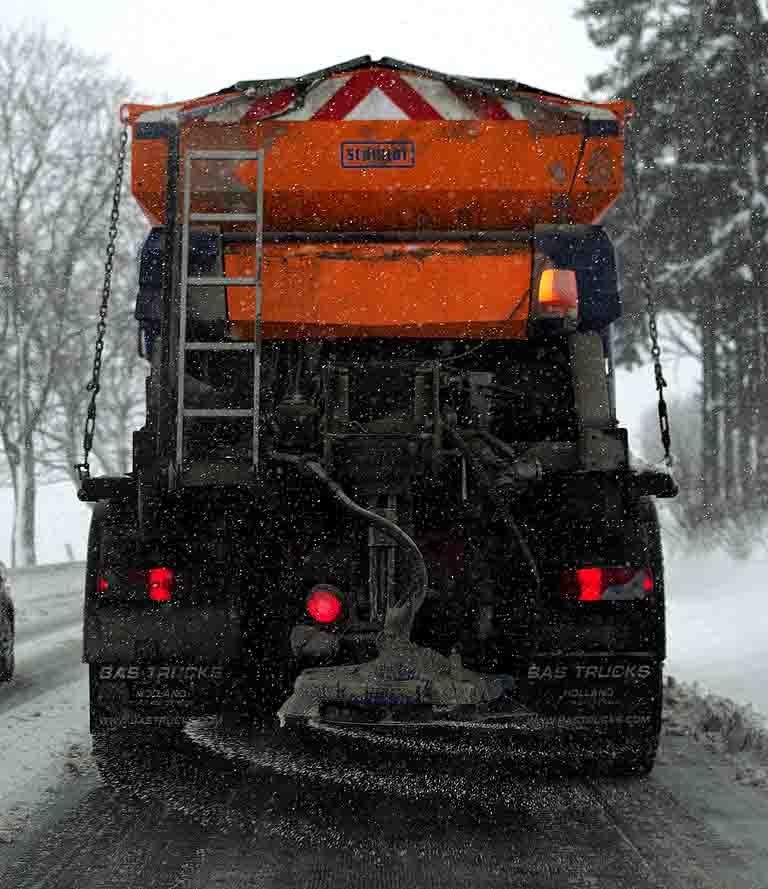
Road salt has, accordingly, become a major contaminant in our fresh water. As ice and snow begin to melt, salt ends up in our local lakes and the Great Lakes. In some areas aquatic habitats are becoming too salty for many freshwater species to survive. In other areas, high levels of salt are also turning up in people’s drinking water and wells. In both cases, scientists point to excessive winter salt use as the culprit.
Using salt is only part of the answer. You can also do the following:
- Wear sturdy footwear designed for snow and ice to help prevent slips and falls. Boots should have a good tread for traction with low, wide heels.
- Put snow tires on your car. Slow down on the road. Give yourself extra time to arrive at your destination. Drive for the conditions. And make sure you give plow drivers plenty of space.
- Use a traction aid like kitty litter or sand – even coffee grounds or sawdust – on areas that tend to become slippery.
To keep your driveway and sidewalk clear of snow and ice:
- Shovel first. When you remove snow and ice by shovelling, you’ll need less salt and it can be more effective. Get out there as early as you can and keep up with storms. You may find that salt isn’t needed.
- Shovel unsalted snow to lower areas or onto lawns to direct melting snow away from paved areas.
- Prevent icy buildups by redirecting downspouts away from walkways and driveways.
- For still-icy patches, use a traction aid like kitty litter or sand to reduce the potential to slip. Sprinkle de-icing material on icy areas only, and follow the manufacturer’s instructions for working temperatures and application rates. Give de-icing material time to do its work.
According to the City of Orillia’s website, “Salt use is kept to a minimum. It is spread only on main (arterial) roads and some secondary collector streets. Salting occurs at the beginning of a snowfall to establish a melting point to help keep streets clear.”
If hiring a snow removal contractor to clear driveways or lots, use certified Smart about Salt Contractors. They’re trained to reduce salt use while maximizing effectiveness and safety. If you feel you must use salt in an area, it takes less than a cup of salt to melt ice from a meter of pavement. When it comes to road salt, less is more.
If you see excessive salt being used, speak to the property owner. Share the environmental consequences of applying too much. Tell them about agencies like Smart About Salt who can help train their staff or contractors in correct winter salt use.
IDLE NO MORE
Canadian winters are legendary. Frigid mornings feature the collective groans of Canadians and their cars as they get their January days underway. But those groans are becoming fewer as technological improvements make newer vehicles more and more ready to roll even on the most brutal mornings. According to Car Help Canada, most recent models need less than thirty seconds to warm up and will do so more efficiently when in motion. Warming up the car is simply no longer a necessity.
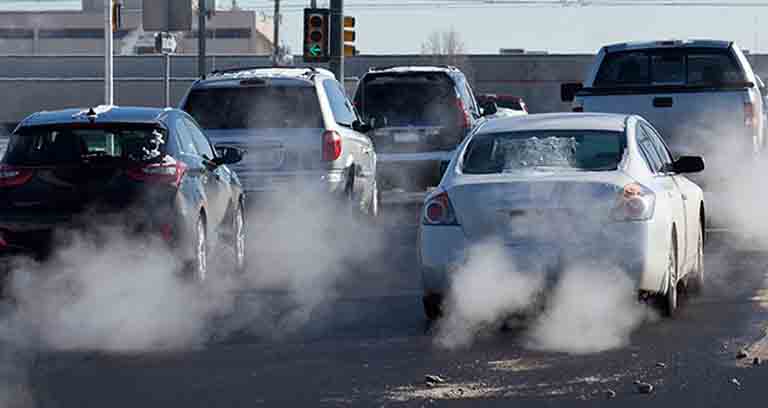
Idling our vehicles less will save money on fuel, improve air quality in our community, and reduce emissions contributing to climate change.
We know asking readers to eliminate vehicle idling in the midst of winter is a big ask– but why not limit your vehicle idling? Consciously cutting it in half or reducing it by ten minutes a day? Or maybe eliminating it entirely? Let’s take a look at a couple of the reasons why these actions make a difference.
It’s calculated over 10 billion gallons of gasoline are wasted each year world-wide from vehicle idling. Idling vehicles for ten seconds or more uses more fuel than restarting the engine, a main reason many new vehicle models are equipped with an automatic engine stop-and-start feature, reducing emissions at every red light or traffic back-up. Reducing our personal vehicle idling by just ten minutes each day translates into an additional eight or more kilometers of travel, saving both gas and money.
Vehicle emissions are the largest contributor of greenhouse gases (GHG) world-wide. Idling a vehicle for just 10 minutes generates the equivalent of a pound of GHGs. When we multiply that by the number of vehicles we see idling everyday, it’s clear that reducing vehicle-idling is a positive step to reduce GHG emissions.
It’s not just the health of our planet that is negatively affected by exhaust fumes. Our health is affected too. Many studies identify the negative effects of exhaust fumes on our health – in particular, our brain cells. School boards have become leaders in restricting vehicle idling in school zones to protect the health of their students.
Another sure-fire way to reduce vehicle idling is to avoid or reduce our use of drive-thrus. Drive-thrus are a concentrated source of vehicle-idling – so much an increasing number of North American cities have taken steps to curtail development of additional drive-thru operations. And consider the additional health benefit of parking, getting out of your car, and walking to and from the coffee counter. Exercise, people, exercise.
Small, individual steps matter. Doing our personal best to preserve our planet and quality of life is the only way we can make a difference and provide role models for our families and friends. Reducing our vehicle idling is one of these small steps.
STAY COZY AT HOME
According to the World Wildlife Federation, if every Canadian turned their thermostat down 2 degrees and put on a sweater while in the house, we could save 4 megatons of greenhouse gas emissions.

Why not borrow the idea of hygge from the Danes?. It refers to a form of everyday togetherness, a pleasant and highly valued everyday experience of safety, personal wholeness and happiness. The word includes something nice, cozy, safe and known. – a warm blanket, a favorite sweater, candles burning nearby, a hot cup of tea, a good book, a cat on your lap or a dog curled up at your feet, and above all, the opportunity to relax in a comfy chair and know that you feel really, really good at this very moment.
While we’re talking about cozy, comfy sweaters, in case you are on the hunt for just the right one, buying second hand is a great option. The fashion industry involves a lot of environmental degradation – from harvesting the textiles and dyeing the fabrics to shipping the products. In the end, many pieces of clothing end up in the landfill after they have been worn for only a couple of years. Each year, over 1.2 million tonnes of textile waste is dumped into the North American landfills.
Once you’ve got that oh, so comfy sweater, consider creating hygge in your favorite room at home. Another tip: hygge is even better with the person you love or a good friend there enjoying the coziness with you.
Tip by: Couchiching Conservancy’s fall 2019 newsletter
BLUE BOX ETIQUETTE PART 2
At a recent Sustainable Orillia public event (Waste Management – November 28) Greg Preston, the City of Orillia’s manager of such things, provided more tips to help make blue boxes work the way they’re supposed to.

- Wrapping paper with sparkly stuff on it cannot be recycled. Best choice? Wrap your presents in paper that can be recycled – or in that bath towel you’re also giving.
- Use one bin for paper and another for containers. Don’t mix items.
- Plastic film is collected by the city – milk bags, bread bags, store bags (cereal liners not included). They must be clean. Then fold it all and place in a clear plastic bag. When the bag is full put it out separate from the rest of your recycling.
- Styrofoam is also collected by the city. Put it into a separate bag and include it in the blue box for paper, not the one for containers.
- Aluminum foil is recyclable – but must be clean.
- Put caps back on pop 2-liter plastic bottles, same with milk cartons – doing so ensures they go to the recycler.
- Paper cups, including McD’s and Tim Horton’s, go into the paper bin; lids go into the garbage
- If you have a contaminated pizza box don’t put it in your blue box. Rip it up and put it in the compost instead.
- Elastic bands? Clips on bread? Into the garbage, please.
- Finally, no propane cannisters. Those are a dangerous hazard.
RECYCLING – BUY USED CLOTHES
The old idea of thrift stores as places with racks of old and tattered clothing is outdated and changing. Climate concerns are driving a boom in a newly energized resale industry, forecast to quadruple in size very soon.
The fashion industry has been criticized for its effect on the environment. Much of fast fashion piles up in landfills, and some have estimated its carbon footprint as larger than that of the shipping and airline industries combined. Buying used clothing helps alleviate these problems, and it appears consumer attitudes are changing.
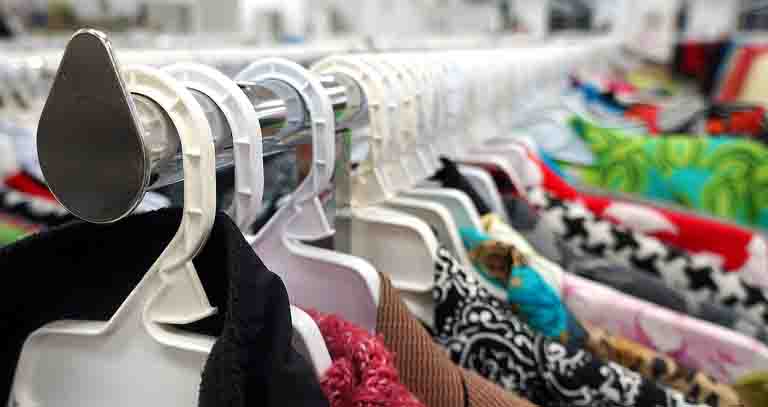
Some fast fashion chains are closing stores due to flagging sales. Retail consultant Bruce Winder said fast fashion’s target market – young, style-conscious shoppers on a budget – are also those most concerned about the health of the planet.
“All the fast fashions these days are just polluting our Earth, so it’s nice to be able to reuse other things that people don’t want,” said one young customer browsing through the coat department recently at a Value Village thrift store. Zero-waste consultant Sophi Robertson says her closet has only one piece of clothing that was bought new, everything else is second-hand.
For some who grew up associating second-hand clothing with being poor, there’s a stigma around second-hand items. But that’s changing quickly. Some give the credit to our children, they are learning about environment issues at school and are taking environmental responsibility seriously. Let’s join them.
SAY NO TO SINGLE USE PLASTIC BOTTLES
Last week, Coca-Cola was named the most polluting brand in the world. Close behind were Nestle and PepsiCo. It’s no surprise, though – Coca-Cola itself recently disclosed that it produces three million tonnes of plastic annually.

Plastic is found everywhere, but one of the most common applications is packaging for drinks, including water. Studies show only 9% of all plastic waste is ever recycled.
The good news is Coca-Cola and other soft drink makers have signed on to a partnership which advocates for a circular economy where nothing is wasted.
In some places, retailers use a system where consumers pay an indirect deposit (i.e. fee built into the price) when buying a drink and upon returning the bottle get a discount on their next purchase. The bottle is cleaned and reused. The program has seen a return rate of over 90%.
The fight against plastic bottle waste is winnable. If you haven’t yet joined the fight, why not start this week by refusing to buy water packaged in single-use plastic – and by promising yourself to never again purchase this product?
TRAVEL TIPS FOR SNOWBIRDS
It’s the time of year when many Canadians are lucky enough to escape some or all of winter by packing their bags and heading south to warmer climes. As some of us cast our thoughts to sunnier days and balmier nights, here are a few reminders from Sustainable Orillia to help us travel light and right.

- Reduce paper. Use your phones to download boarding passes and tickets.
- No matter whether you are flying or driving, if you haven’t already invested in a set of refillable plastic containers, then please do so.
- Most airports and rest-stops along the way have recycling bins for plastics, paper products and so on; take an extra moment to sort your garbage. Be sure to follow the local guidelines.
- Consider buying carbon offsets. Most airlines offer carbon offsets. For a small fee you can help neutralize your personal travel carbon footprint.
- If you’re flying bring your own headphones and reject the plastic-wrapped set.
- Be mindful, it’s easy to lose track of things when we’re on the road. Keep personal things together and organized, especially those items that contain plastic. The better care we take, the less likely something will get lost and need to be replaced… which ultimately means less plastic or waste that ends up in landfills or the sea.
Little things, by lots of people, make a big difference. These are just a few thoughts on how we can integrate sustainable behaviors in all parts of our lives no matter where we spend our winters. If you have any ideas on sustainability you would like to share, please let us know and in the meantime – travel safe and travel right.
THE LAST STRAW
Did you know that Canadians throw out 57 million plastic single-use straws everyday? Do you know where they end up? In landfills–and even worse, in our waterways and oceans where they take over 300 years to break down and doing irreparable damage to the well-being of our planet and of the folks and fish who live on it.
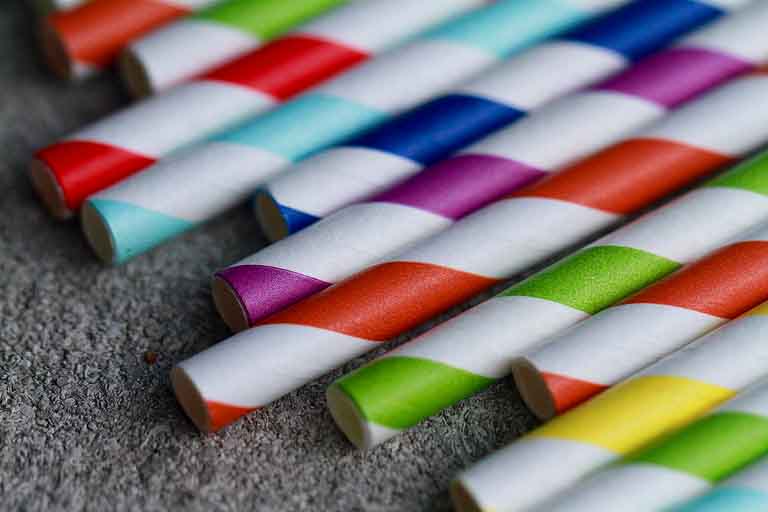
Let’s do something about this. Whether at home, in the grocery store, or at a restaurant or bar – say a big no to plastic straws.
Choose paper straws. Better, choose straws made of reusable, long-lasting materials like stainless steel, glass or bamboo–all of which are available on-line or through local outlets such as Home Hardware, The Dollar Store and Giant Tiger.
Make your last plastic, single-use straw truly Your Last Straw.C
ARE YOU A BLUE BOX BUSTER?
Orillians have a wonderful record of blue box usage and we can be rightfully proud of the attempts we have made over past years to reduce waste going to our landfill.
But sometimes the items we intend to recycle end up going to the dump. Why? Some reasons follow:

- If you neglected to wash and rinse food particles out of the container it goes to the dump.
2. If you’ve ignored the greasy stain on the cardboard pizza box It goes to the dump.
3. If you’ve misread the symbol on the product )the symbol with the 3 arrows means the package was made from recycled content) It may not be recyclable at all, and yes, off to the dump it goes.
All of us need to know the local rules for Blue Box recycling—and follow them closely. Otherwise, a lot of our efforts are for nothing.
NATURAL CLEANERS DO THE JOB
Vinegar, lemon, hydrogen peroxide, and baking soda, you probably already have these in your kitchen or bathroom. Did you know they can also be used to clean your house more cheaply and often more effectively than commercial cleaning products?
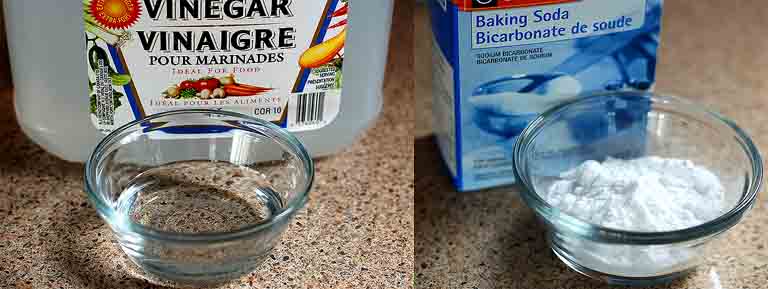
The April/May edition of Chatelaine magazine provides a detailed look at how these products can be used to cut grease, deodorize, disinfect, lift dirt and even whiten.
In addition, going online with a search for “cleaning with natural products” also turns up recipes for everything from a room deodorizer to how to clean the grease from your BBQ.
Like other planet-saving actions, these will also save you money and are better for your health.
SCARY HALLOWEEN TREATS

We know that Halloween treats are not always good for kids’ dental health. They can also be scary from an environmental perspective: Many contain palm oil, which may be produced in a way that causes deforestation and horrifying outcomes for endangered rainforest animals.
The Toronto Zoo has launched a campaign asking people to choose treats that protect rainforests, listing brands that use certified sustainable palm oil:
- Mars (Twix, 3 Musketeers, M&Ms, Snickers, Dove, Skittles)
- Hershey’s (Reese’s, Turtles, Whoppers, Twizzlers, Jolly Ranchers)
- Frito-Lay (Lay’s, Ruffles, SunChips, Tostitos, Cheetos)
- Quaker
- Ferrero
- Kraft Heinz
- Lindt & Sprungli
According to the World Wildlife Fund, many consumer products contain palm oil, from lipstick to soap to ice cream. Consumers can help by choosing products carefully.
WHERE’S THE BEEF?
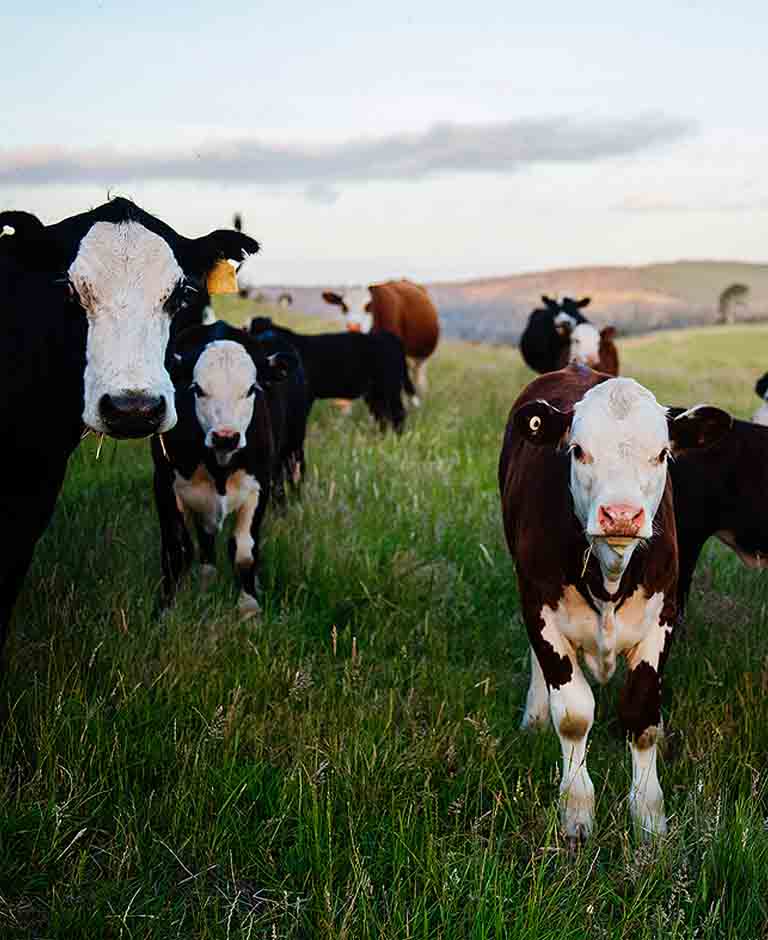
Who knew that eating meatloaf, hamburgers, and steaks was bad for future generations? Twenty years ago no one, that’s who. But now we know raising millions of cattle to produce beef is one of the primary sources of greenhouse gases (GHGs).
So changing our diets becomes one way we can make our way of life more sustainable. Face it, it also shrinks our food bill, making our weekly or monthly income also more sustainable.
Work at this. Substitute other meats for beef (see the Glory Bowl recipe online). Better? Plan a couple of meatless meals each week.
WINTERIZING YOUR GARDEN
There’s nothing like a beautiful fall day as red and yellow leaves fall gently onto our lawns and gardens. Gardeners, by nature, are long-term planners and although those falling leaves tell us that its time to prepare our flower and vegetable beds for winter’s blast, our thoughts are always focused on the season ahead.
Increasingly our thoughts are on how best to integrate sustainable practices into our gardening regimes. The mantra of Reuse, Recycle and Repurpose applies as much to gardening as it does to other parts of our lives.
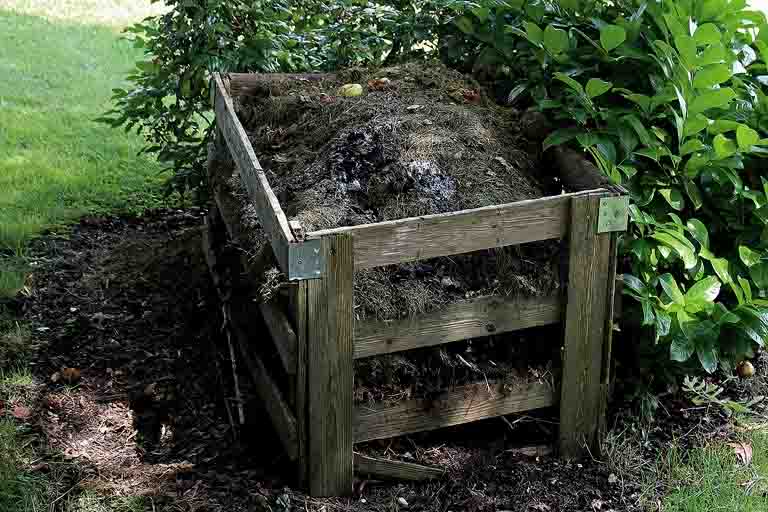
For example, as you prune or pull out your plants, chop them up and compost them for next year’s beds. If you don’t already have a composting system in your garden, start small in a corner of your garden with a simple pile of the chopped-up plants, cover with dirt and let nature take its course. You’ll be able to add this organic matter directly to your garden’s beds next season.
Do you have a stack of used plastic plant containers in your shed? This is a good time to take them back to your local nursery where they can be repurposed for next year’s plantings.
What about water? It’s never too late to find a way to capture rain water for the garden. Just remember to empty your container before it freezes. A good rain barrel not only reduces wasted water, it also adds character to the garden.
Winter is when most gardeners plan (and dream). This winter gardeners are encouraged to learn more about how they can integrate sustainable practices into those gardening plans. There is lots of helpful information on-line, and we here at Sustainable Orillia will be posting ongoing tips throughout the seasons to help build better gardens naturally. Meanwhile, enjoy autumn’s glow as you wind down another season and prepare for the next.
DO YOU REALLY NEED A CLOTHES DRYER?
Automatic clothes dryers account for a lot of electricity use in an average household – more than your clothes washer, fridge and TV combined.
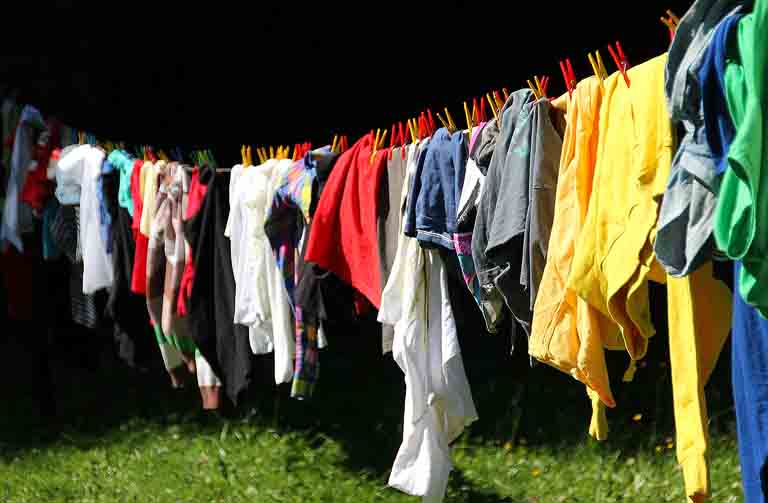
Clothesline drying is one of the easiest ways to save energy—and your money. You save 100% of the cost simply by hanging your clothes up to dry.
Clothesline drying is a simple task from a simpler time. Drying outside, if possible, is best, since clothes dry faster and the sun has a sanitizing effect. Indoor drying, especially in winter, adds welcome humidity to your home.
Get a clothes rack at your local hardware store for $25. Thanks for the tip Tony Telford.
GOT A DITCH? THINK BIOSWALE!
You can help the environment and beautify your home by planting a bioswale. A bioswale is typically a vegetated channel that carries storm-water runoff from streets, parking lots and roofs. The effect is to filter and slow down runoff water while making it cleaner and safer for the environment, allowing it to sink into the ground rather than run into streams and lakes.
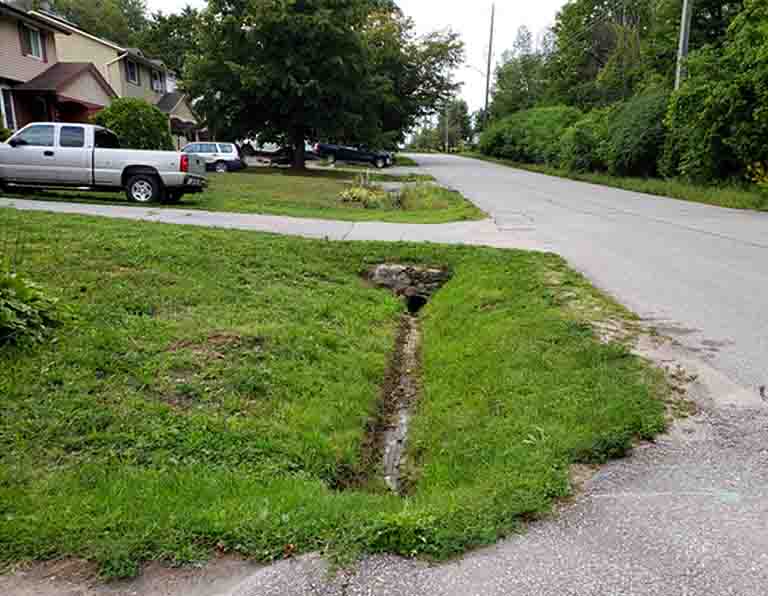
Some storm-water management practices, such as storm sewers and concrete channels, may be effective in handling runoff, but they’re ultimately eyesores. Bioswales offer a more pleasing alternative. They add aesthetic appeal to a residential or commercial site with texture, colour and habitat for birds and butterflies.
During seasonal shifts, city sewer and storm-water systems can struggle to keep up with increased water runoff. A 4 meter bioswale can absorb about a quarter of the total rainfall runoff that it receives.
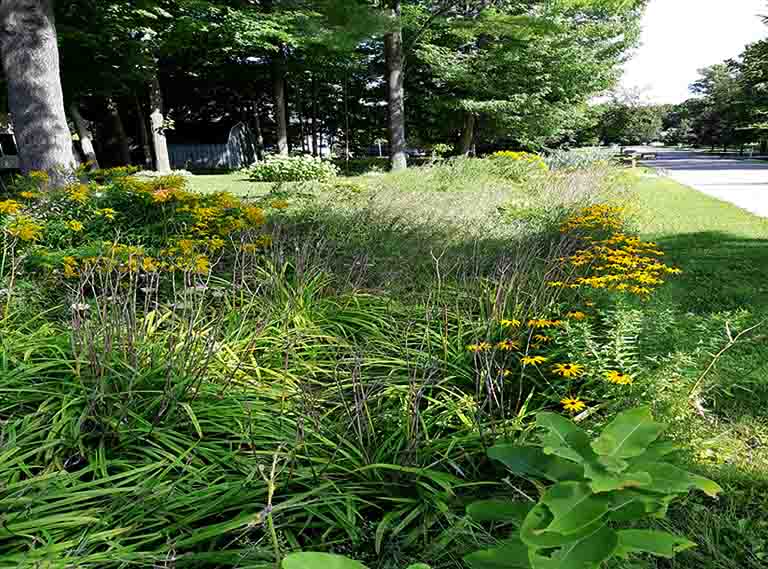
Once established, a bioswale needs little maintenance. They are vegetated with hardy native plants with established root systems which can withstand drought and a heavy downpour. While they are most effective in dealing with frequent, small rainfalls, they are also important in areas susceptible to storms. Liven up your landscape with a bioswale You’ll not only protect our lakes and reduce the load on our city infrastructure, you’ll also beautify your home. Thanks for the tip Dorthea and Jane
ATTRACT POLLINATORS TO YOUR GARDEN
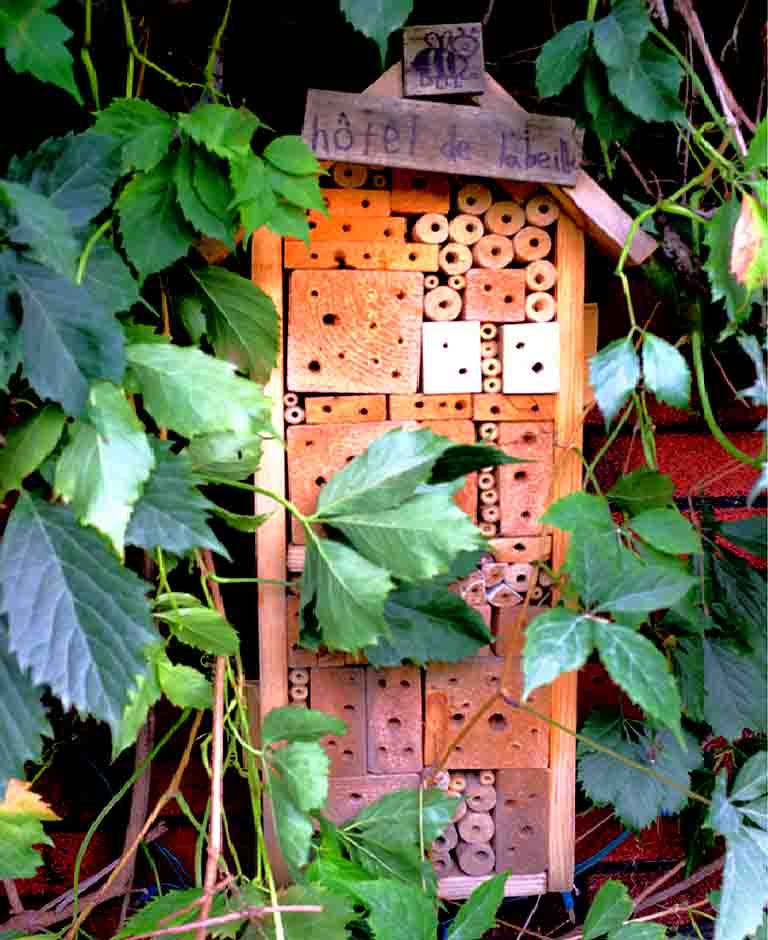
Birds, bats, bees, butterflies and beetles pollinate plants and are responsible for bringing us one out of every three bites of food. Worldwide, over half the diet of fats and oils comes from crops pollinated by these little critters. They transfer pollen grains from one flower to another, and facilitate the reproduction in 90% of the world’s flowering plants.
Pollination leads to the production of fruits we eat, and the seeds that will create more plants. Pollination begins with flowers. Gardeners can support pollinators by providing pesticide-free food sources, safe shelter, and access to clean water. Having variety in your plants and their bloom times will help attract and support pollinators. Consider planting a portion of your lawn with native wildflowers to act as a pollinator garden (you’ll save time and lawnmower gas). Butterflies such as the monarch are an important model species for ecologists when determining the health of an eco-system. Many gardeners plant milkweed in their eco-friendly gardens to attract monarchs by providing a source of food for monarch caterpillars. Another way to ensure local bees set up shop in your yard is to install a bee house or bug hotel.
JUMP ON THE BUS, GUS
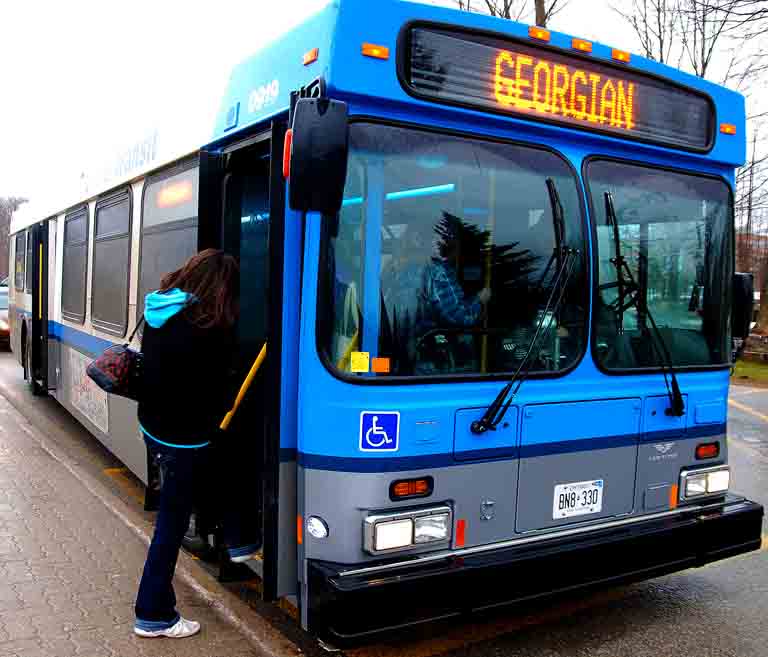
Take Orillia Transit or plan to carpool at least a couple of days a week. If possible ride your bicycle to work. Walk, even. Get some exercise—your body will thank you.
Driving to Toronto often? Take the GO bus or the GO train from Barrie instead. The new LINX bus will take you to Barrie for $4. It goes every 50 minutes between 6 am and 6 pm.
Learn how to connect with Toronto subways and buses. Leave the driving to someone else. The average family spends 20% of their family income on transportation. This means that reducing use of our cars can save us thousands of dollars each year.
Transportation is the source of 25% of our carbon emissions in Canada. So we’re saving money, but we’re also saving the planet. Let’s do it.C


